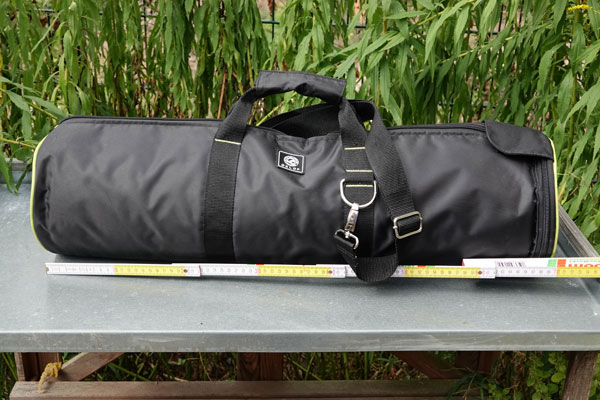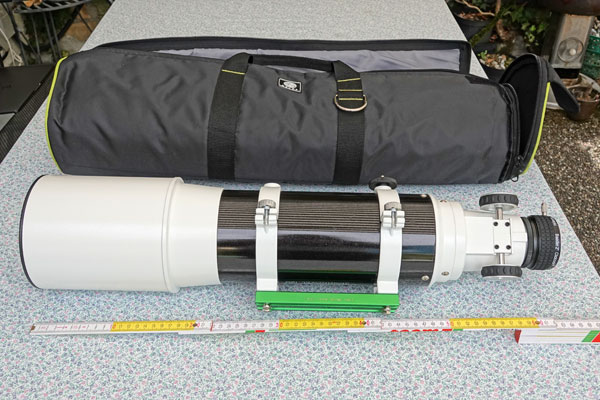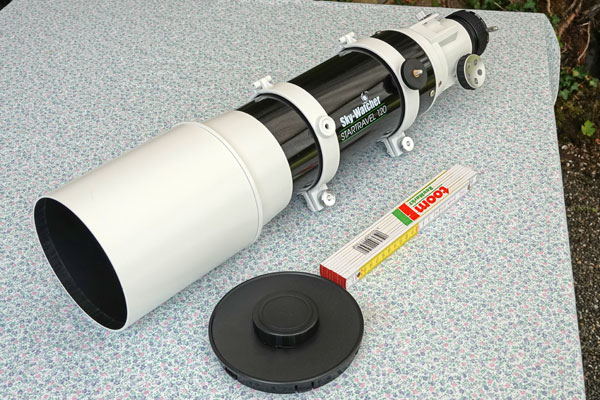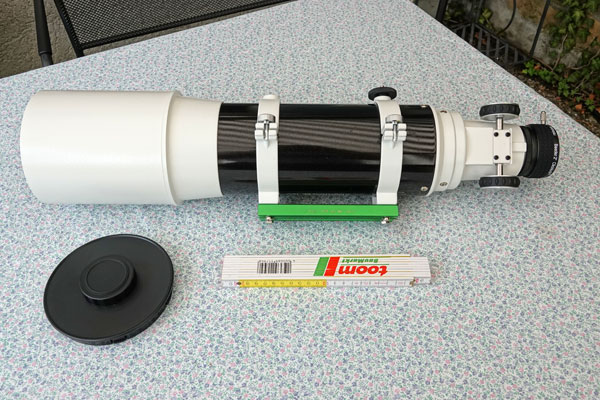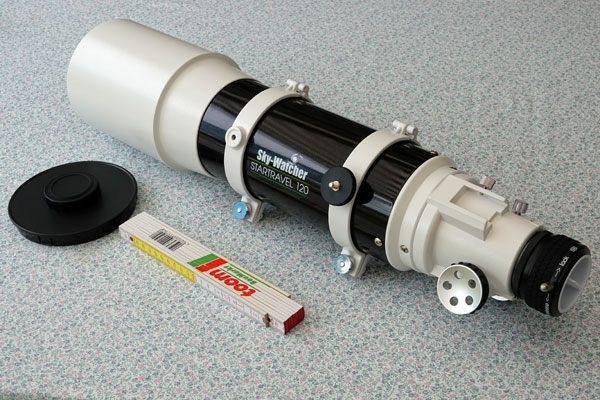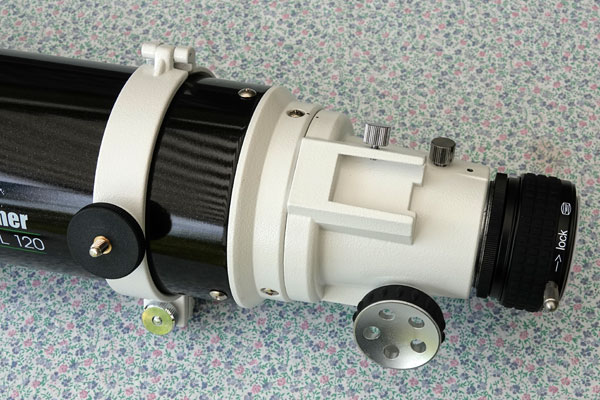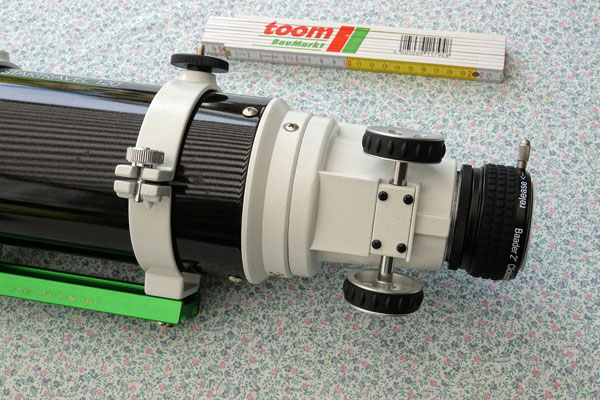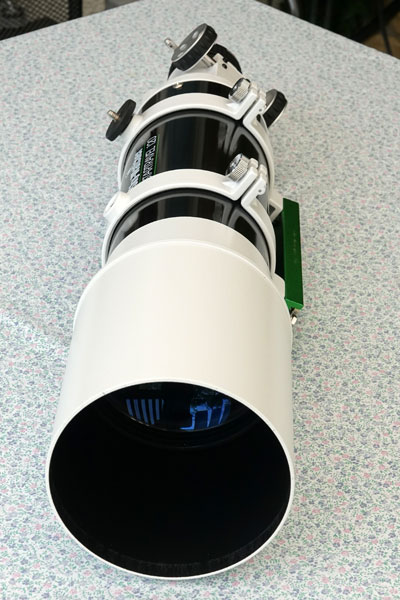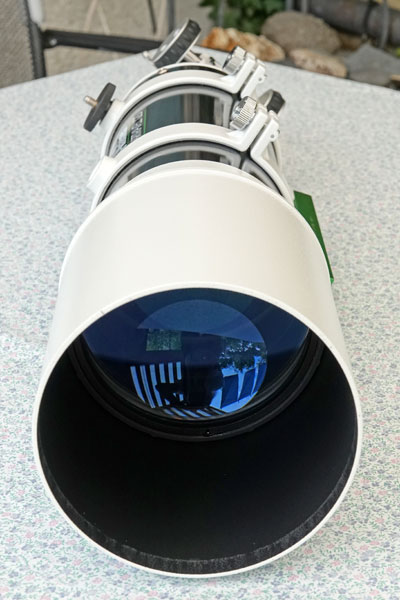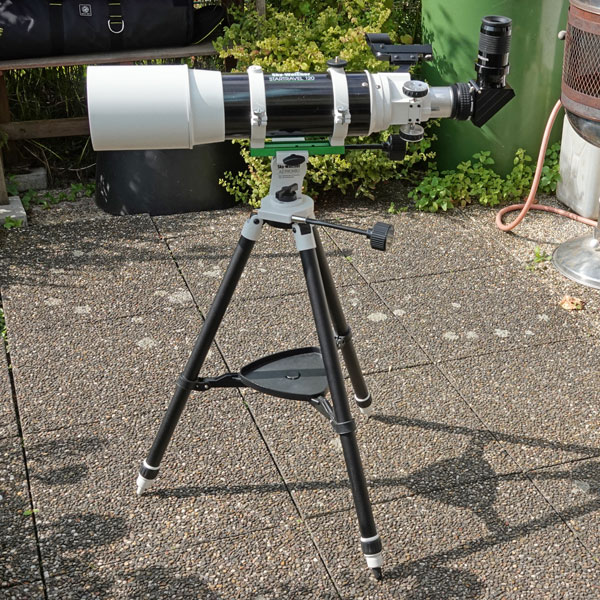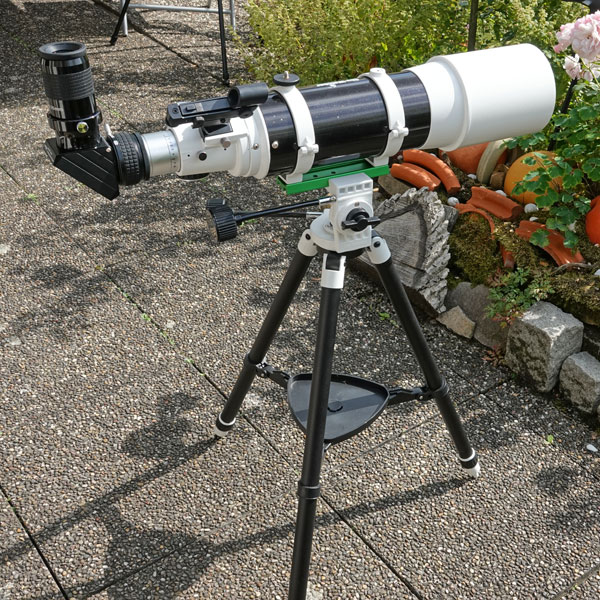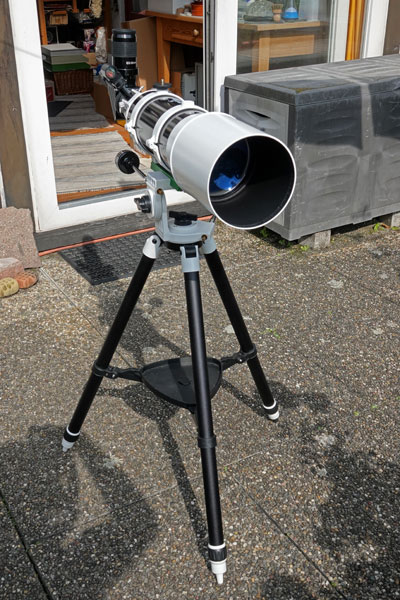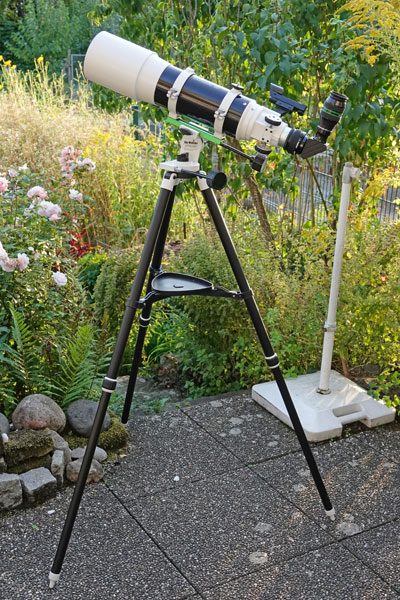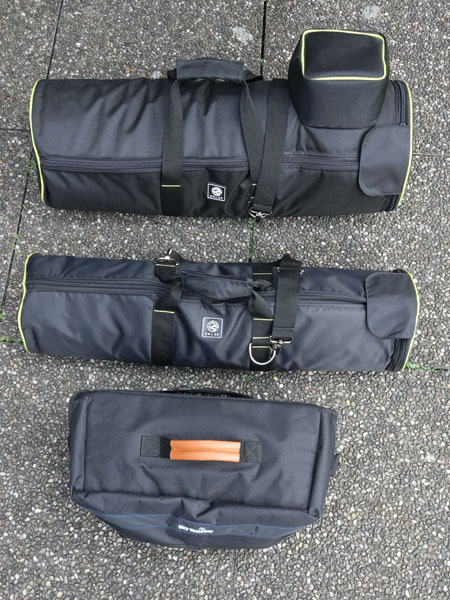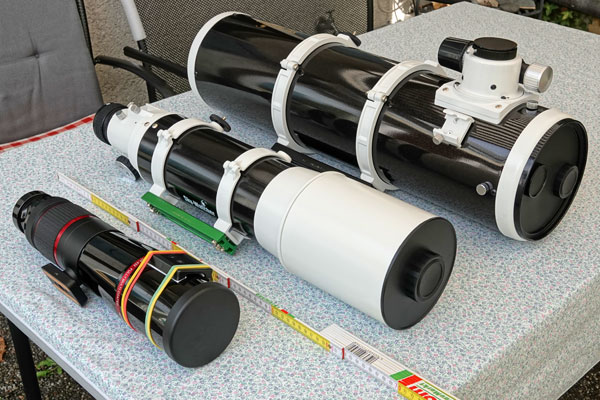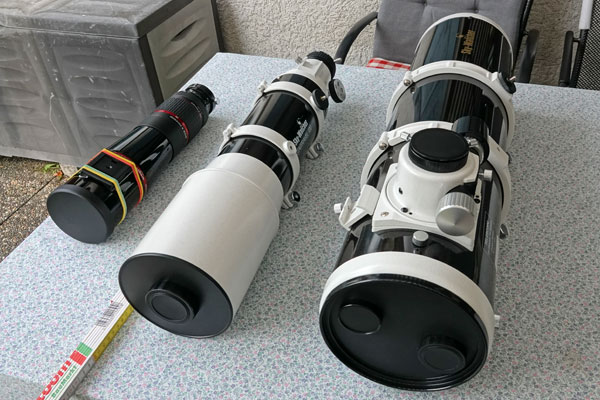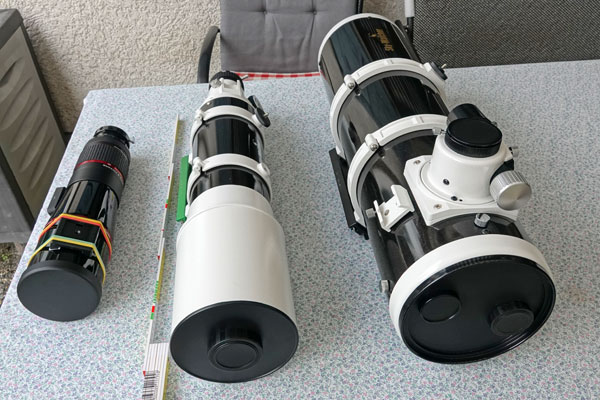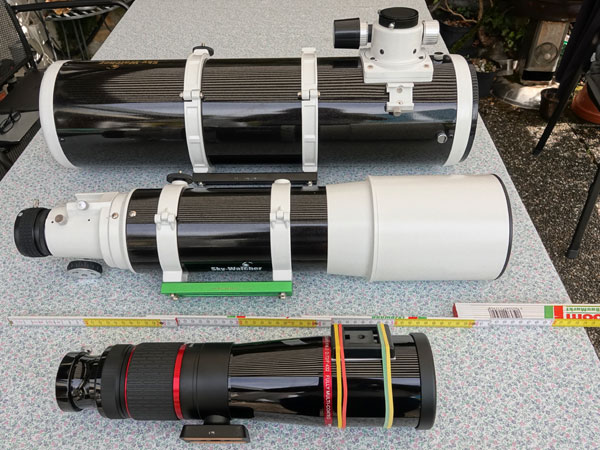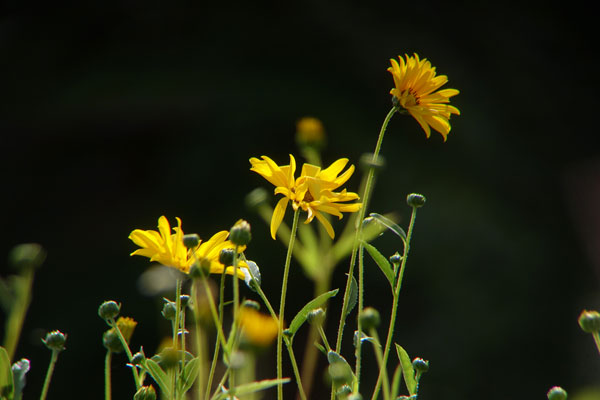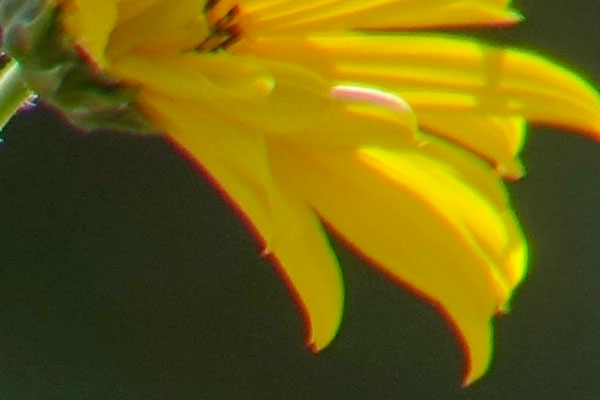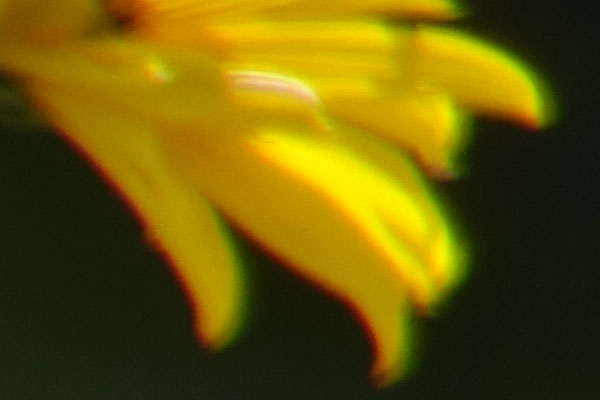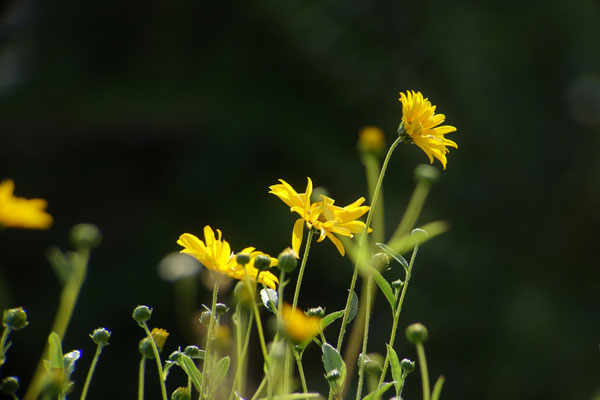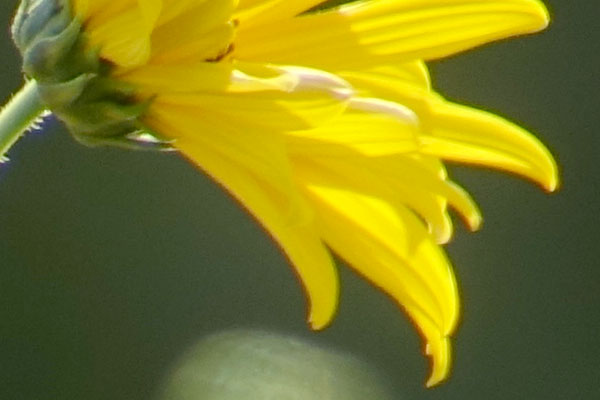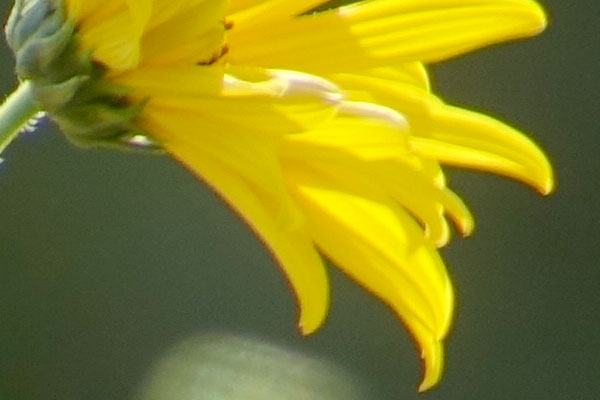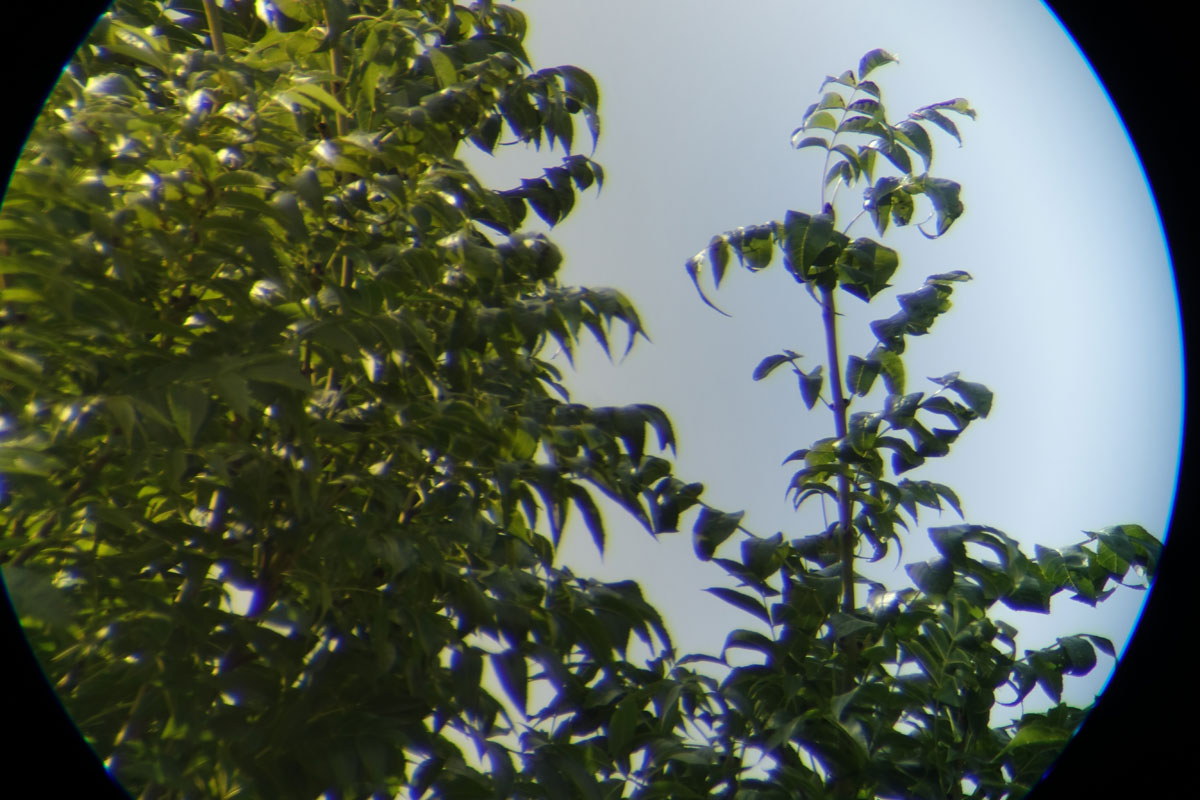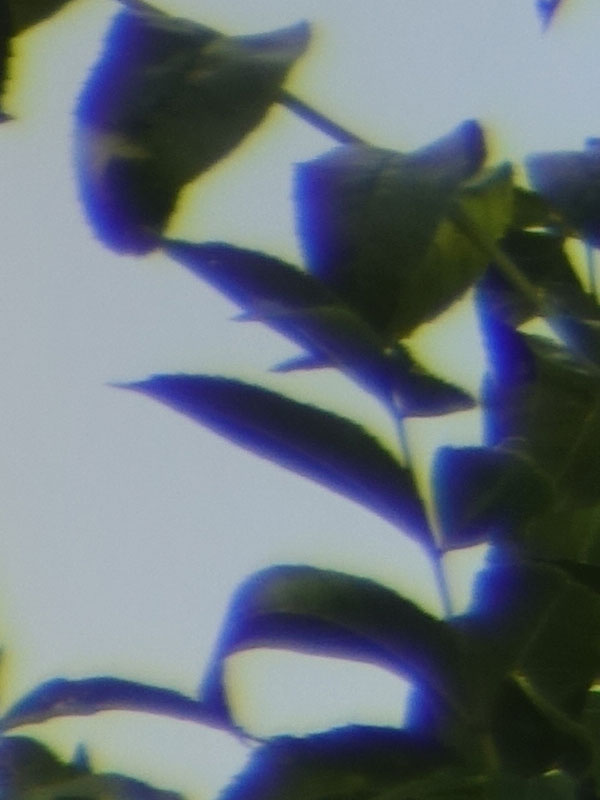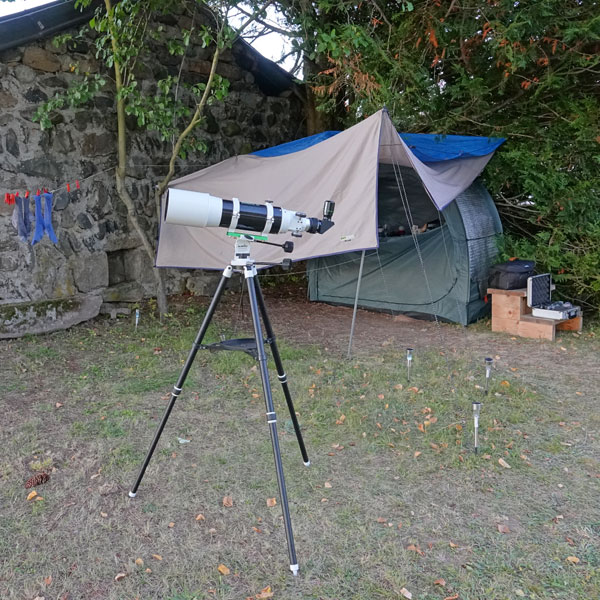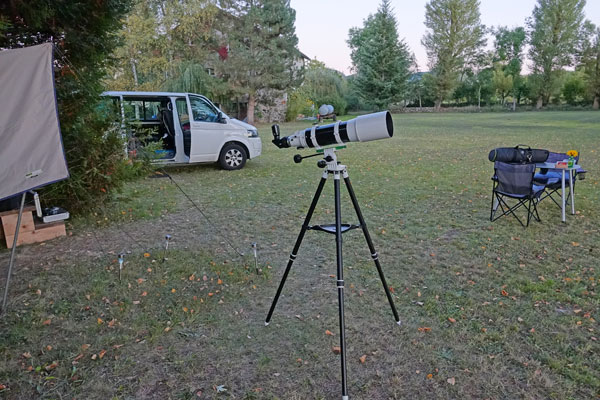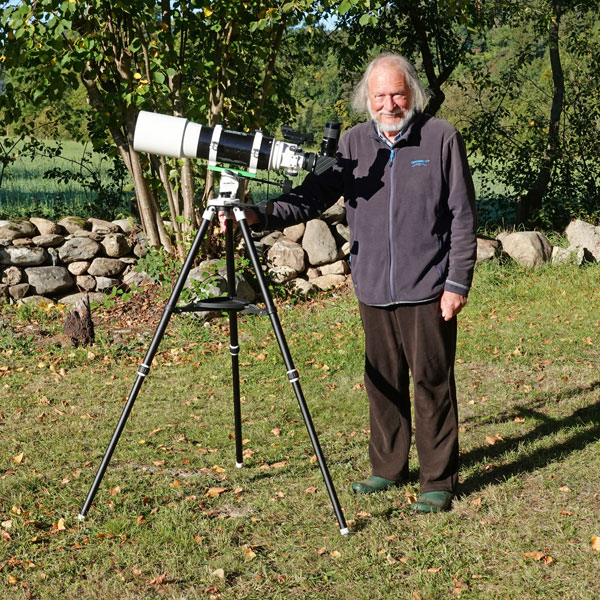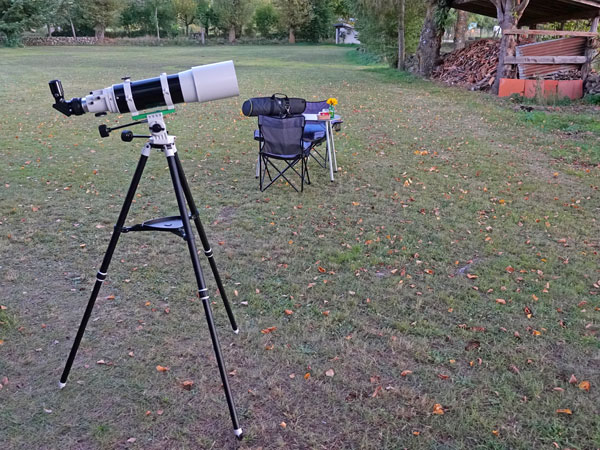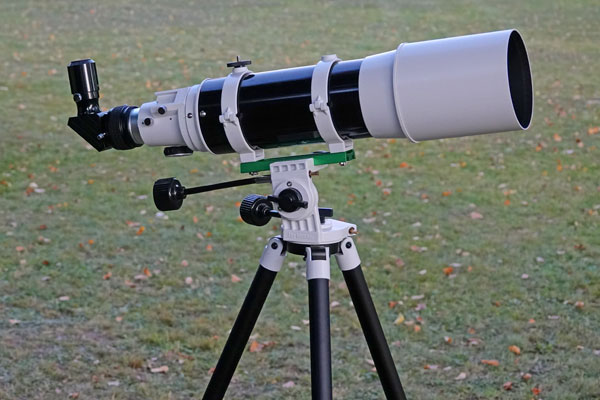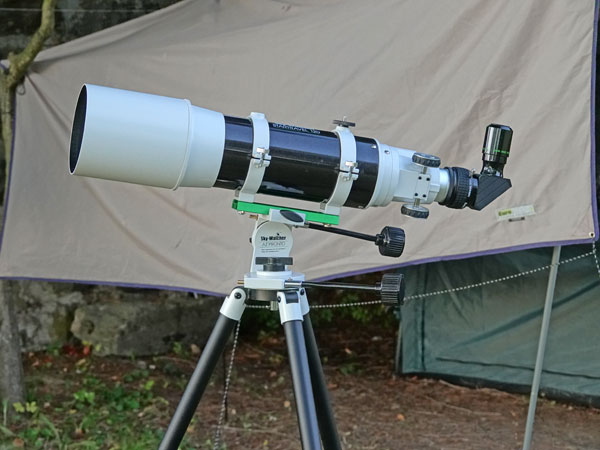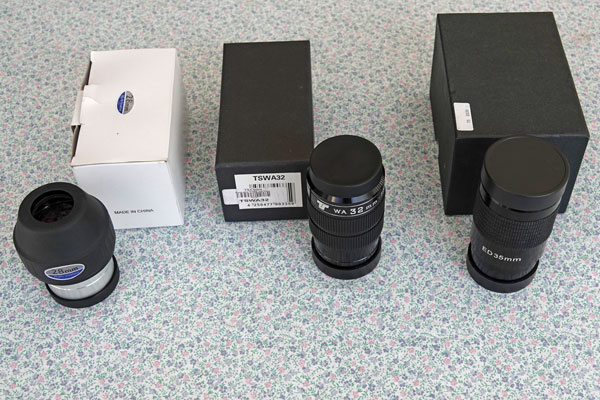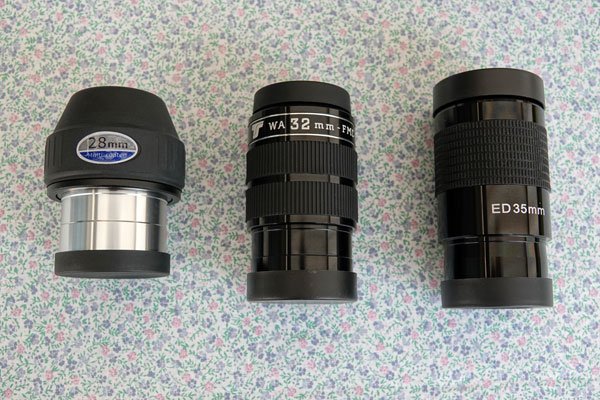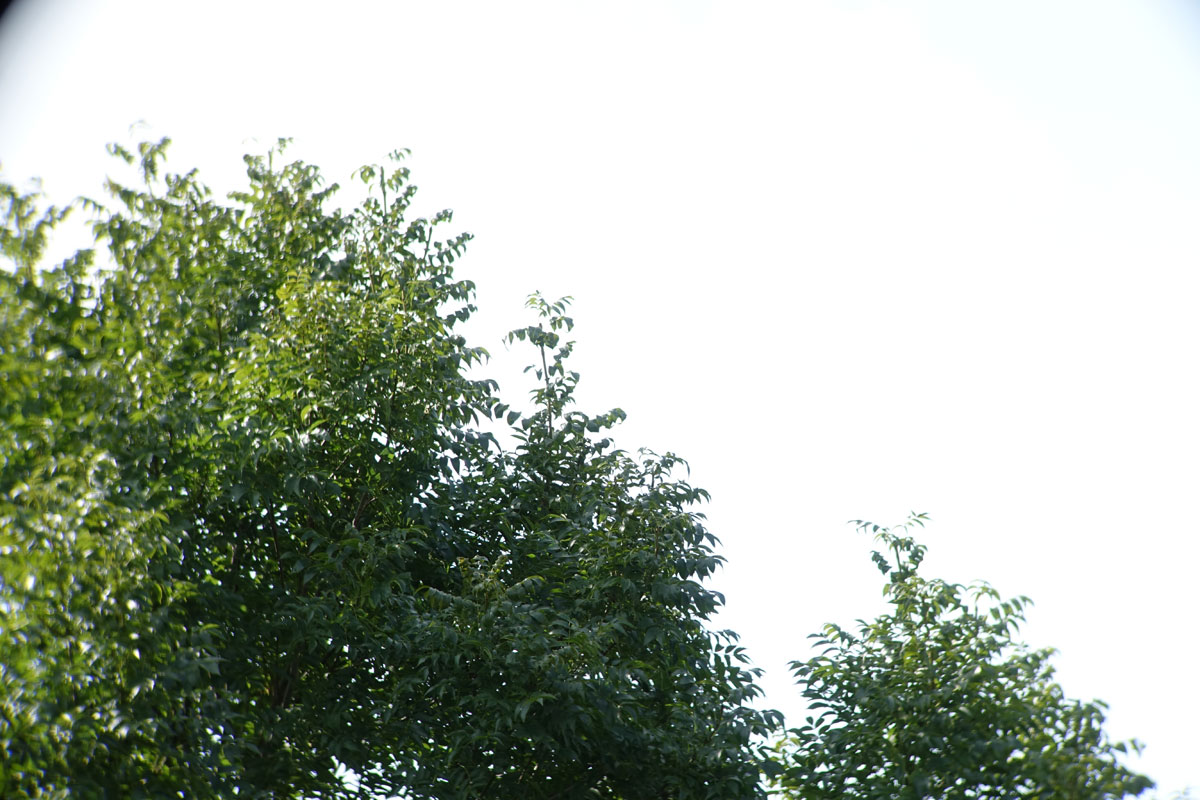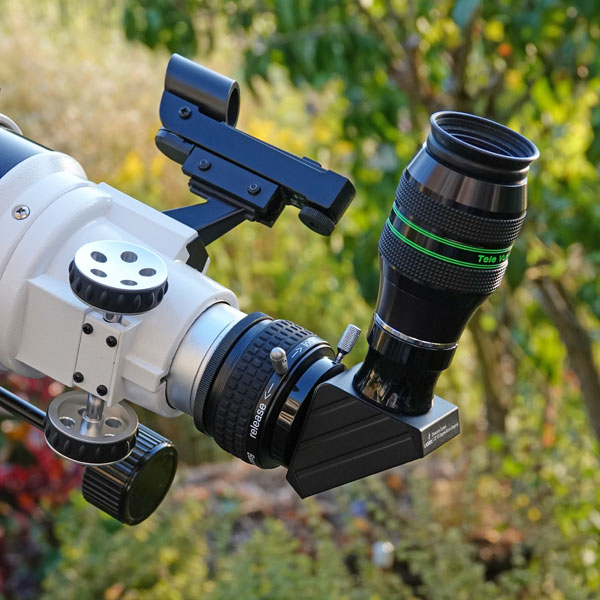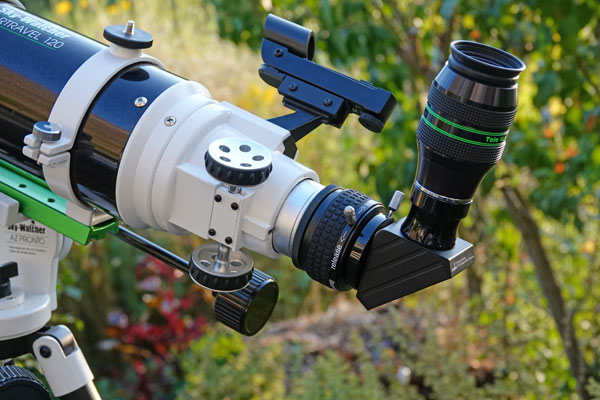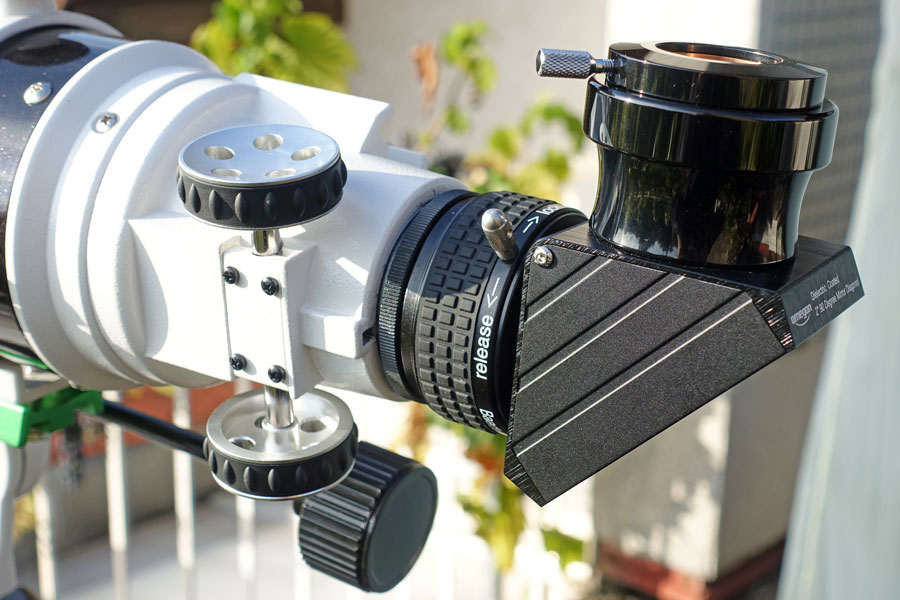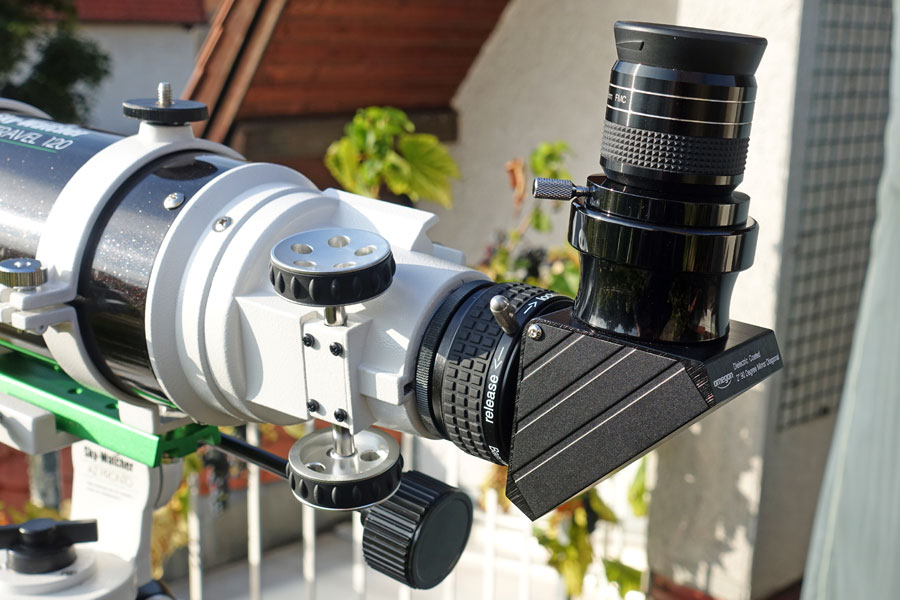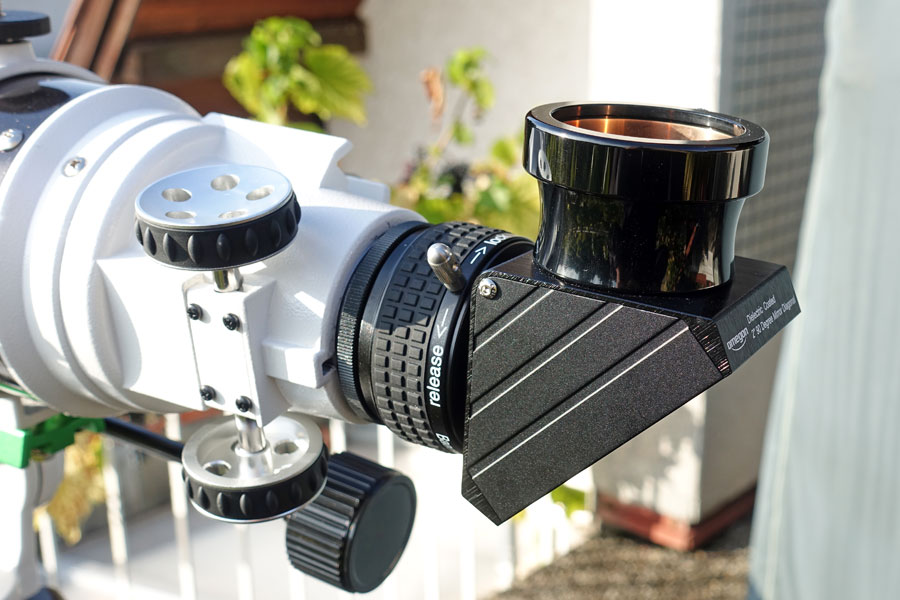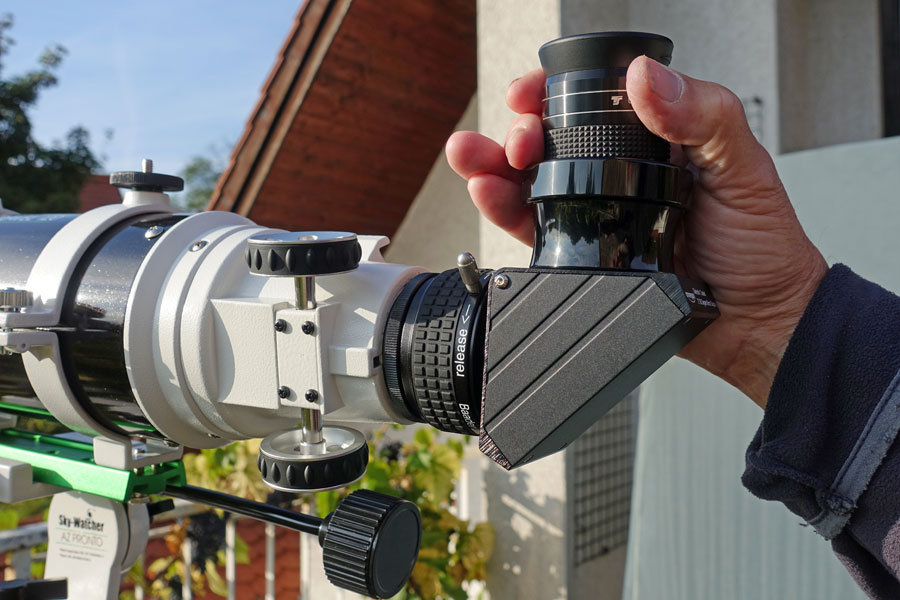Sky-Watcher Refractor StarTravel 120/600 (Borrowed)
Motivation | Look | Visited Sky Objects | First Experiences | More Experiences | Issues | Photo Attempts | Conclusions | Links | Appendix: Data | Appendix 2: Sky-Watcher StarTravel 120/600 Report
Archive
On this page I provide some information about the 4.7" Sky-Watcher refractor AC 120/600 StarTravel OTA (borrowed on September 6, 2019; returned in October 23, 2019). For simplicity, I will mostly call it (Sky-Watcher) StarTravel 120/600 or just ST120. I wanted to test this telescope for its suitability to quick-and-dirty observations, particularly of DSOs, but also for use on vacation.
| Note: I returned the ST120 at the end of October 2019 to its owner. I therefore can no longer report any experiences with this scope here. |
Note: The Orion telescope AC 120/600 might be a more or less identical version of this telescope (it looks more like an older version of it, though).
Motivation (for Borrowing it)
Refractors are praised again and again for their sharp and constrasty image, but also criticized because of their color aberrations. Only refractors with very expensive glass seem to be free of color aberrations. And not always seems too be "ED" inside where there is "ED" written on the tube... Although I had no experiences with refractors so far, the praises that I have read have enticed me again and again to purchase one. Every time I found a cheaper refractor on the Internet, I called my astronomy dealer and asked him for his opinion on the respective device. And he advised against it again and again because of the strong color aberrations, so that I never purchased a refractor. This changed, however, in September 2018, when I visited the AME2018 astronomy fair in Villingen-Schwenningen and ordered the Omegon refractor PS 72/432 ED. My experiences with this telescope are positive - and not so positive - and can be found elsewhere on this site. Overall, I am satisfied with the PS 72/432, but there was something that bothered me: I was not able to find a lot of deep sky objects even under the dark French night sky. And I got the suspicion that an aperture of 72 mm might be a little small after all.
In my search for refractors with more aperture, I quickly hit at limits, especially financial ones. The only inexpensive refractor with a large aperture is the Sky-Watcher refractor AC 120/600 StarTravel OTA (or its Orion counterpart). But this is a refractor of the Fraunhofer type and is therefore often called a "paint bucket." In other words, with an otherwise good optical quality, color fringes can be expected. So the question arises: How much do these color fringes disturb in practice and under what conditions are they still acceptable? I think that you can only answer this question for yourself by trying out the device. So I decided to do this by buying the refractor, but not without asking my astronomy dealer about the refractor before the purchase. In a telephone conversation, he called the refractor inexpensive and in view of its low price also "worth considering". However, he found it too similar to my Sky-Watcher Explorer 150PDS with respect to the technical data, and therefore both would compete*. The dealer pointed out that many hobby astronomers are discovering gaps in their equipment where there are none at all. And afterwards they sell the devices again. Well, that took the wind out of my sails, although I would have liked to take the refractor on vacation to France and test it there...
*) When I take a look at the eyepiece data further down, I have to agree with him. But are more arguments to this, like the handling and the suitability to travel, for example.
But not quite, because I know a hobby astronomer with whom I exchange e-mails and who owns such a refractor. I asked him about his opinion on the refractor as well, and he offered to lend me the refractor for a while. He even allowed me to take it with me on vacation. I was not able to refuse this generous offer, the delivery was exciting, and in the meantime, the refractor was with me on vacation and was tested under different conditions. I report my experiences below and with respect to the observations during my vacation on page Deep Sky Summer/Autumn Observations September-November 2018.
Look
Refractor StarTravel 120/600
|
Telescope in Oklop bag |
Ditto taken out of the bag |
Ditto |
|
Telescope oblique front view |
Ditto, side view |
Telescope oblique rear view |
|
Clampshells |
Back with shoe for the viewfinder |
Ditto with focuser |
|
Front view |
Ditto |
Telescope alone, no accessories |
Refractor on AZ Pronto Mount
Center: with 1.25" zenith mirror |
Visited Sky Objects
I have visited the following sky objects with the Sky-Watcher ST 120/600 (about 50 DSO):
- Moon (Half Moon)
- Jupiter, Saturn
- M 2, M 4 , M 8, M 9, M 10, M 11, M 12, M 13, M 14, M 15, M 16, M 17, M 18, M 19, M 20, M 21, M 22, M 23, M 24, M 25, M 26, M 27, M 28, M 31, M 33, M 34, M 35, M 42/43, M 45, M 51, M 54, M 55, M 56, M 57, M 69, M 70, M 71, M 75, M 76, M 80, M 81/82, M 92, M 103, M 107
- Mel 20
- NGC 457, NGC 663/NGC 654, NGC 752, NGC 884/NGC 869, NGC 7000
- Kemble's Cascade, Cr 399
Highlights
- Moon
- Planets: Jupiter, Saturn
- DSO (galaxies): M 31, M 81/82
- DSO (globular star clusters): M 2, M 13, M 15, M 22, M 55, M 92
- DSO (open star clusters): M 11, M 23, M 25, NGC 457, NGC 884/NGC 869
- DSO (nebulae): M 8, M 16, M 17, M 57
First Experiences
Size Comparison with My PS 72/432 and Explorer 150PDS
When my astronomy hobby friend handed me over the StarTravel 120/600 in its Oklop bag, I found it quite handy. And it occurred to me that I also own an Oklop bag for my Explorer 150PDS, but it seemed much bigger in my memory. To check this more closely, I simply placed three telescopes side by side in their bags: the StarTravel 120/600, the Explorer 150PDS (the largest of the three) and the PS 72/432 (the smallest of the three). I do not transport the latter in its suitcase, but in a bag from Sky-Watcher, because it is more handy and still offers space for accessories. So this bag is rather not suitable for comparing the telescope sizes... As you can see, the bag of the ST120 is almost as long as that of the 150PDS. But because it has a smaller diameter and the "package" is also a bit lighter, the filled ST120 bag appears much more handy and is also easier to stow than the filled 150PDS bag. The former is still "suitable for holidays," while the latter is not. The bag for the PS 72/432 is a certain "brick", but apart from the eyepiece case and the tripod everything is included. The other two telescopes require another box for accessories, which takes up space as well.
Figures: Telescopes in their bags and alone
If you then unpack the telescopes and place them next to each other, you can see that the ST120 is almost as long as the Explorer 150PDS. But because of its smaller diameter and weight it seems much more handy and manageable, which I quickly confirmed in practice. Nevertheless, my wife thinks that the ST120 is quite big, and she is not quite wrong, especially if you compare the ST120 with the small PS 72/432. That little telescope is even more handy!
As a Spotting Scope...
Motif: Sunflowers
Figure: Photo with zenith mirror and TSWA32 eyepiece (left), section from the photo (center); section from a blurry photo (right)
Figure: Photo with zenith mirror and TSED35 eyepiece (left), section from the photo (center); section from another photo (right)
I compared the performance of the StarTravel 120 as a spotting scope with that of the PS 72/432 on sunflowers against a dark background and found no differences. Above all, I did not notice any color fringes visually. But I did not take any photos here. Later, I compared the two wide-angle eyepieces TSWA32 and TSED35 on the ST120 and took photos this time. While I had not noticed any color fringes visually, I was able to recognize them in certain places on the photos afterwards. On the sample photos above, you can also see that the TSWA32 produces stronger color fringes than the TSED35.
Motif: Trees Against a Bright Background
The following photos of trees were taken with the StarTravel 120 against a bright background. This is where color fringes usually show up strongest, as I know from my TS binoculars. I show example shots with different exposure and sharpness, because color fringes appear more strongly on blurred photos. I do not remember the eyepiece anymore, but it does not play a big role here.
| Original | |
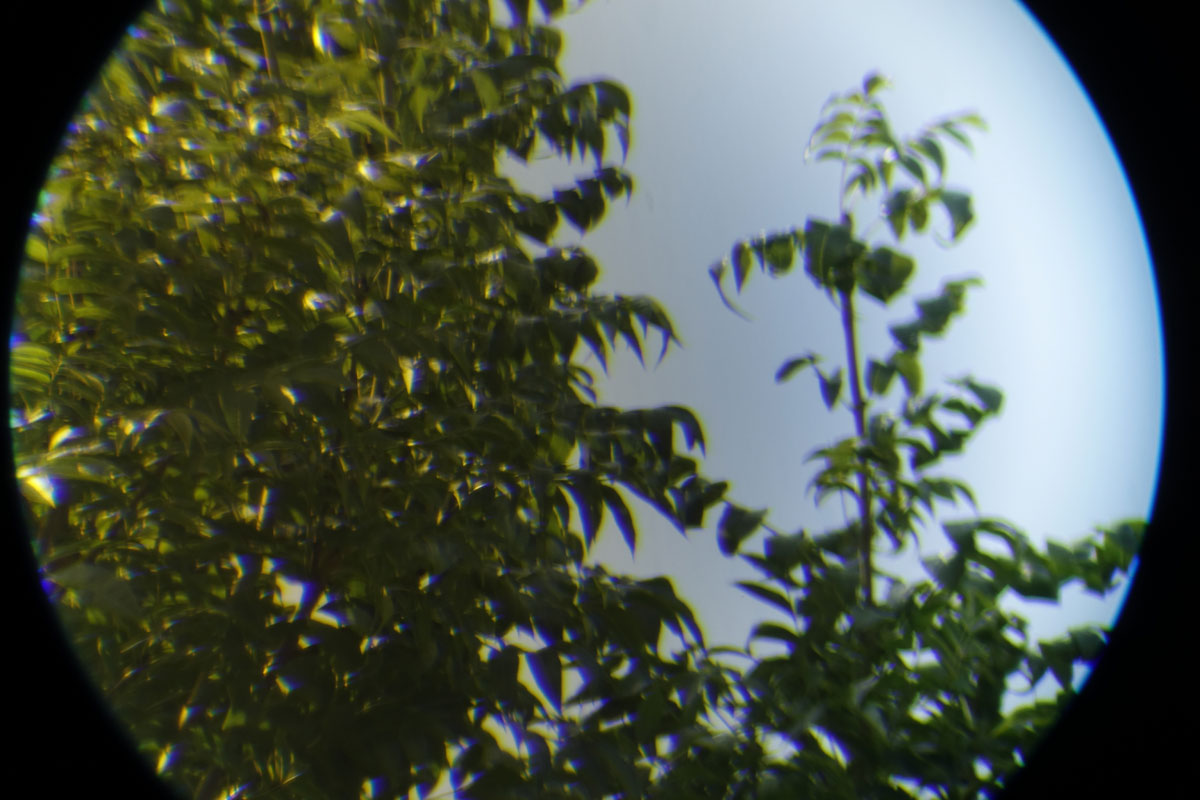 |
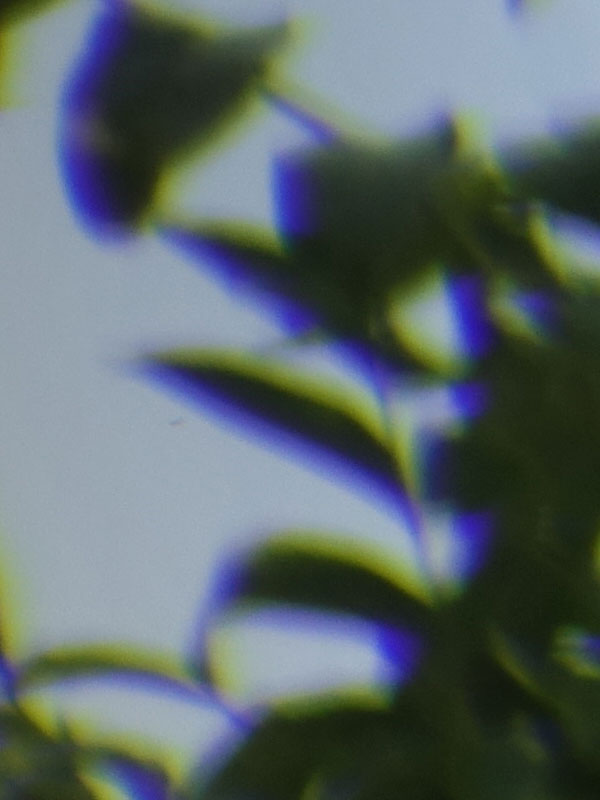 |
| Original | |
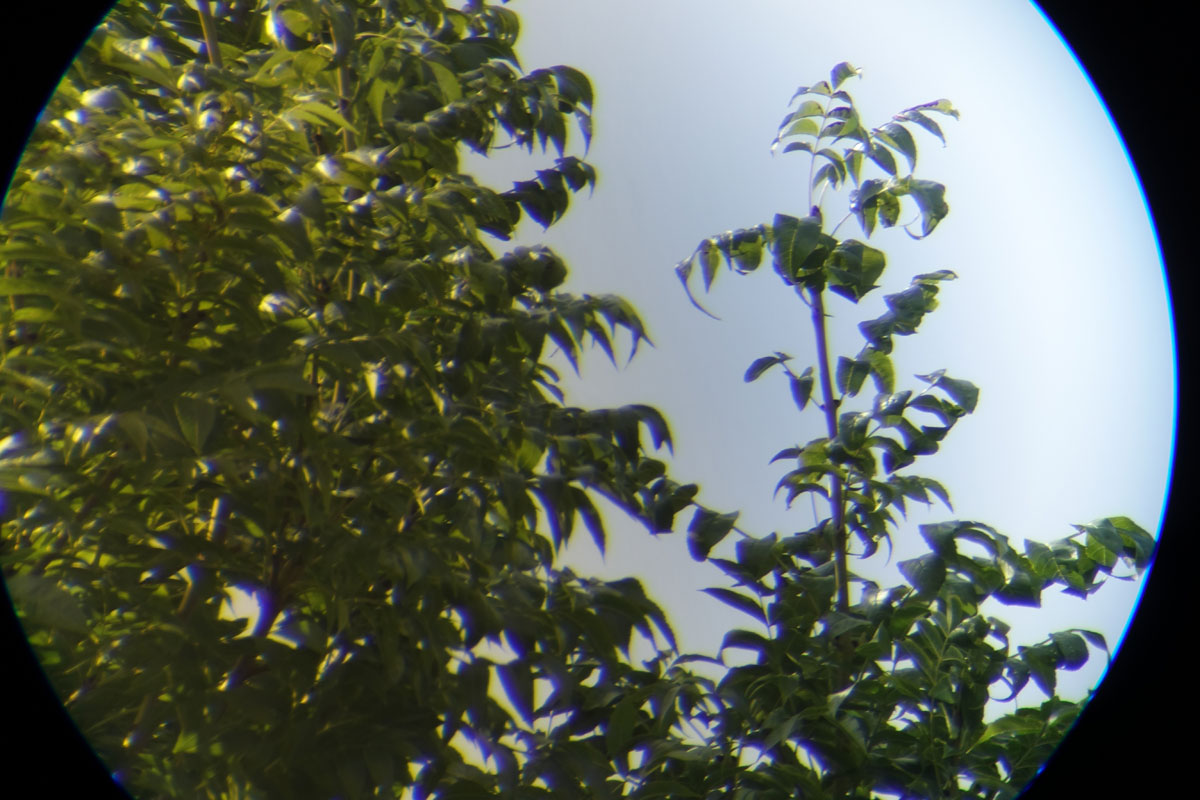 |
 |
| Original | |
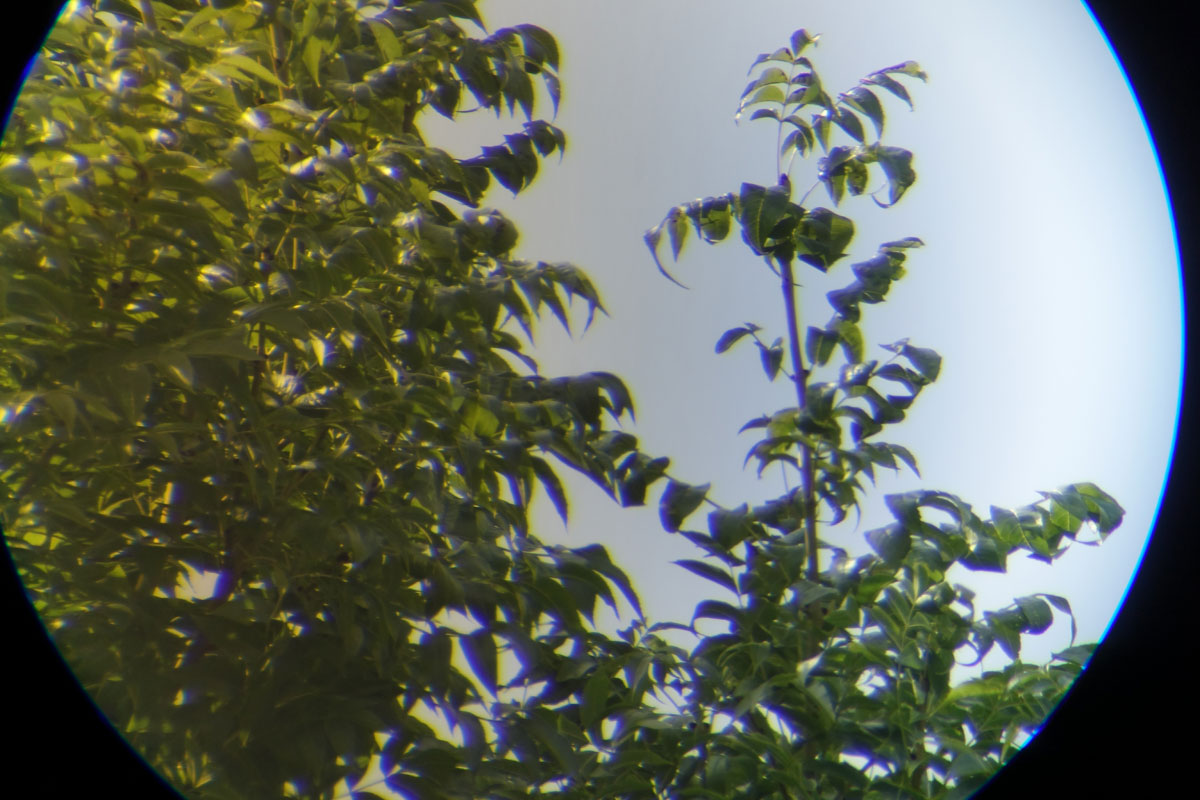 |
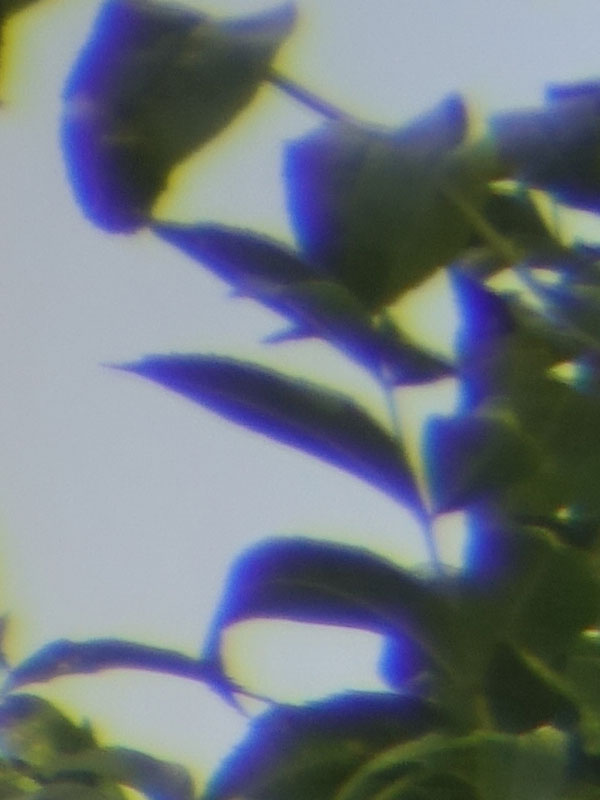 |
| Original | |
 |
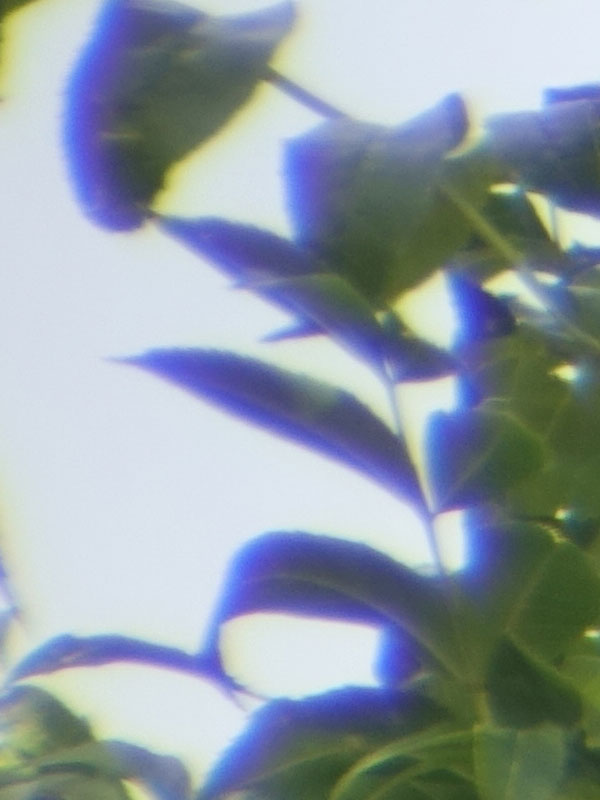 |
| Original | |
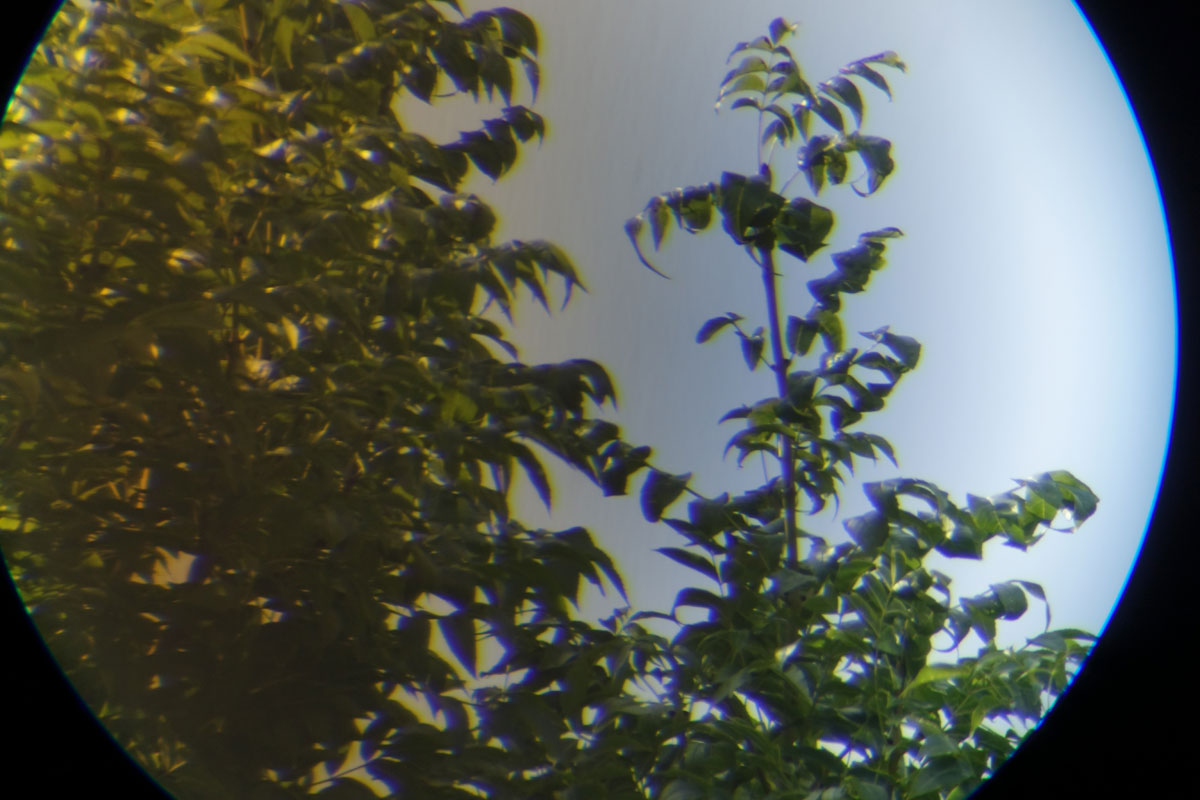 |
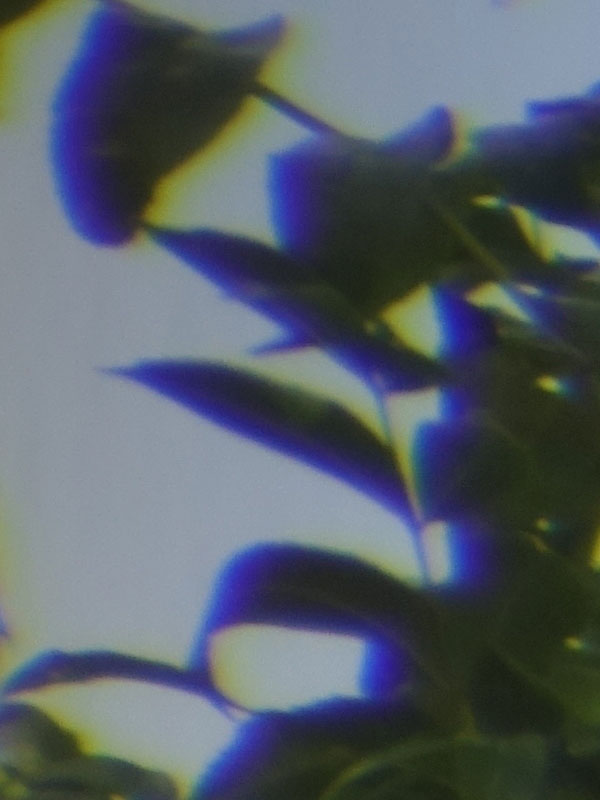 |
| Original |
Figure: Variants of the same motif with different exposure and sharpness (see also the original photos)
The PS 72/432 showed similar color fringes (not shown), but to a lesser extent, thus, it is not free of them either. All in all, this situation is an extreme case and should not be overestimated, especially with regard to night-time behavior.
First Thought...
As a spotting scope, the StarTravel 120/600 would compete with my small refractor PS 72/432 and the "thick" Maksutov-Cassegrain Skymax-127. For this task, I would definitely prefer the PS 72/432, especially since it allows lower magnifications than the Skymax-127 (I rarely need high magnifications in daylight), exhibits less color fringing than the ST120, and is much more handy than the other two telescopes. If necessary, I can even put the PS 72/432 on a photo tripod.
As a Telescope (First Night)...
Already on the first day, the weather was good enough to carry out the first tests of the StarTravel 120 in the evening and night sky. I observed the half moon, the planets Jupiter and Saturn as well as the DSOs M 13 (Hercules Cluster) and M 11 (Wild Duck Cluster). I put the ST120 on the AZ Pronto mount and used it with a 1.25" zenith mirror, because when using the 2" zenith mirror did not come into focus with some eyepieces. I also used the two 2" wide angle eyepieces with the 2" zenith mirror for testing purposes, but I was not sure whether I had really focused exactly. For comparison purposes, I used the PS 72/432 on a photo tripod, with which I was not able to access all objects. For the most part I used a 10 mm eyepiece on the ST120 and a 7 mm eyepiece on the PS 72/432. Then both telescopes enlarge about 60 x.
I already observed the half moon when hardly any surface details were visible. The brighter the moon became, the stronger yellow and blue color fringes appeared in both telescopes. On the ST120, however, I estimated them to be twice as wide. Both telescopes showed a brilliant image, maybe the PS 72/432 was even a bit more brilliant (my wife said so), and both showed a rather restless image, the ST120 even a very restless one at times, as I had never seen it before. I am not yet decided whether the color fringes on the ST120 will bother me. They are mainly visible at the already blurred moon edge, while crater details did not seem to be influenced by them. I think, however, that my Skymax-127 is the first choice for observing the moon, even if the image there appears less contrasty (which is sometimes also advantageous).
Jupiter with 3 moons and Saturn appeared beautifully in both telescopes. But in the ST120, Jupiter was a bit more colorful than in the PS 72/432. With the ST120, on the other hand, I was able to quickly enlarge up to 150 x (4 mm eyepiece), where the PS 72/432 is already at its end and then delivers a rather dark picture.
I found the globular cluster M 13 only with the ST120; I was not able to find it with the PS 72/432 on a photo tripod. At low magnification, M 13 appeared as a distinct blurred spot, and at 150 x magnification, I was able to see fine stars. Because of the half moon this was, however, not as pronounced as some days before, when I observed M 13 with the Explorer 150PDS and the Skymax-127.
The open star cluster M 11, also called wild duck cluster, appeared very beautifully at low and high magnifications, although not as beautifully as some days before because of the moon. In the PS 72/432, I observed it only at low magnifications, where it appeared more nebulously, in the ST120 also at magnification of up to 150 x, whereby fine stars appeared (150 x).
Overall, the ST120 did not disappoint me, but was also not able to show its full performance because of the moon. When observing DSOs, I did not see any annoying color fringes, but brighter stars quickly become "colorful", which does not have to be annoying as long as you observe them visually. I found it pleasant that I was easily able to achieve a magnification of 150 x with my eyepieces without having to use a focal extender. I do own them, but I do not really like to use them...
First Thoughts...
For observing the moon and also the planets, I would prefer my other telescopes to the StarTravel 120/600, especially the Skymax-127. But also the PS 72/432 seems to deliver a better image (more contrast) than the ST120. Only at high magnifications, which are possible on the moon, the PS 72/432 cannot keep up - but that is where the Skymax-127 is for. However, I would not buy the ST120 because of this application, but for the observation of DSOs (on vacation, however, it would be the only telescope and therefore used for this purpose as well...).
During the first nigt, I only observed two DSOs - and I liked the results for both. However, a real comparison with my other telescopes with respect to this task would have been desirable for this "borrowing experiment", but remained restricted to the Orion Nebula M 42 and the Wild Duck Cluster M 11 because of poor sky conditions...
More Experiences
Second and Third Night with the ST120...
On September 9 and 10, 2019, I observed the moon as well as the planets Jupiter and Saturn in Mühlhausen using the StarTravel 120 on AZ Pronto, and also I took photos (1:50 method, camera Sony RX100 M4 held to the 10 mm eyepiece). On the first day, I observed and photographed the Golden Handle (Montes Jura) on the moon once again. Due to the yellow color fringes of the ST120, the Golden Handle appeared yellow, so to speak "golden." This can also be found on the photos (more or less pronounced), which I found very nice. Sample photos can be seen below! I also observed the planets Jupiter and Saturn (up to 150 x), I tried to take photos of Jupiter (150 x; see below), probably not of Saturn.
The next day, the Terminator had already migrated well beyond Montes Jura and especially the crater Gassendi and Mare Humorum were well visible. I observed Jupiter with magnifications of up to 150 x; I saw four moons, three of them on the right (orientation in the telescope). My wife saw the stripes particularly well at 150 x (10 mm eyepiece). I even observed Saturn at magnifications of up to 300 x (4 mm eyepiece and 2 x focal extender). That was not very sharp anymore, but I found it acceptable - and Saturn was a lot larger. I was, however, not able to recognize the Cassini division despite all my efforts...
All in all, the ST120 showed its suitability for the moon and the big planets on these days. It also magnifies higher than my PS 72/432 - and sometimes the color fringes can even show a nice effect, as the "golden" Golden Handle proves... It is another matter that other telescopes are perhaps even better suited for these purposes... I did not come to observe DSOs on these days, and because of the moon I will have to wait for my holiday in France in order to collect more experiences with respect to this application.
The StarTravel 120/600 on Vacation in France
In September 2019, I took the StarTravel 120/600 with me on holiday to France (Sumène, Haute Loire), where the sky is much darker than in Mühlhausen (the Astronomy club Orion43 has its observatory in Le Betz not far from us). I also took my PS 72/432 with me to see, which objects I would be able to observe with it (and if so, how).
During the first three nights, the sky was dark from about 9 p.m., and the Milky Way could be seen well, but from about 10 to 11 p.m. the rising and waning moon became noticeable, and the Milky Way gradually disappeared. In the time in between, I was able to observe a number of objects with the ST120, namely in the first and third night. I was very pleased with the telescope, especially as there were no color fringes with DSOs. In the second night, I observed with my PS 72/432 under a presumably darker sky and could observe all objects in a similar quality as with the ST120. Since I could not use both telescopes at the same time, a comparison was difficult and had to be delayed until I would be back home. In any case, with the ST120 I can, if necessary, magnify up to 150 x with my 4 mm eyepiece, whereas with the PS 72/432 the upper limit is at about 100 x. Beyond that, the view gets very dark in the eyepiece anyway... The larger magnification makes the difference, especially with open star clusters, but also with globular star clusters, because now you can resolve fine stars.
Until the end of our vacation, I did more observations, albeit with interruptions, including a comparison between my TSED35 wide-angle eyepiece and a borrowed TSWA32 wide-angle eyepiece. Read more below! I also did some rich field observations with my TSED35, but my focus was on "collecting DSOs" to get an impression of which objects I can find with the ST120. In total, I observed about 50 DSOs, among them about 20 new ones, because I wanted to extend the list of observed DSOs a bit. The details of my observations can be found on page Deep Sky Summer/Autumn Observations September-November 2018.
The StarTravel Compared with My Three Telescopes (as of October 2019)
On our vacation in France, the StarTravel 120/600 proved to me its suitability for finding and observing DSOs. How others would judge this, may be a different matter, because in general the ST120 is regarded as a rich field telescope and not as a "DSO hunter"... On vacation I only made a brief comparison with my PS 72/432. And this was not done on the same, but on successive days, on which I observed with both telescopes approximately the same objects (altogether this was only a small part of the altogether observed objects). This result might lead to the conclusion that the PS 72/432 is on par with the ST120, but such a conclusion was not justified in reality. I therefore compared my own three telescopes with the borrowed ST120 at home once again. This was done under partly bad observation conditions and at (almost) only one object, which was fairly easy to find, namely M 11 (wild duck cluster). This comparison was also subject to restrictions and should be taken "with a grain of salt". But the results are logical for me, because they are based on the "effective" aperture of the telescopes:
- Oct 12, 2019 in the morning - Comparison of the ST120 with the
PS 72/432 at the Orion Nebula M 42/43 (the light of the setting moon disturbed
the observations somewhat): The nebula appeared clearly better in the ST120
than in the PS72. The trapeze was well visible at sufficient
magnification in both telescopes.
ST120: 10 mm Televue Delos (60 x); PS72: 7 mm UWA (approx. 62 x) * - Oct 13, 2019 - Comparison of the ST120 with the PS 72/432 at the
Wild Duck Cluster M11 (full moon, clouds appearing at the end of the observation):
the nebula-like glow appeared much better in the ST120 than in the PS72.
ST120: 10 mm Televue Delos (60 x); PS72: 7 mm UWA (approx. 62 x) * - Oct 14, 2019 - Comparison of the ST120 with the PS 72/432 and
the Skymax-127 at M11 (clear sky, clouds appeared at the end
of the observation): the nebula-like glow appeared better in the ST120 than
in the SM127 and clearly better than in the PS72.
ST120: 10 mm Televue Delos (60 x); PS72: 7 mm UWA (approx. 62 x); SM127: 24 mm Televue WA (62.5 x) * - Oct 16, 2019 - Comparison of the ST120 with the Explorer 150PDS
at M 11 (clear sky, clouds appeared at the end of the observation):
the nebula-like glow appeared better in the Exp 150 than in the ST120 .
ST120: 10 mm Televue Delos (60x); Exp150: 24 mm Televue WA with double focus extender (62.5x) or 16 mm UWA (approx. 47x) *
The preference order would be for me: Explorer 150 PDS > StarTravel 120/600 > Skymax-127 > PS 72/432. Basically this order follows, as already mentioned above, the size of the aperture, because the Skymax-127 as a Maksutov-Cassegrain telescope has a quite large obstruction (approx. 30%), while the StarTravel 120 as a refractor has none. To what extent the aperture ratio plays a role in this comparison, I cannot say at the moment.
*) Despite very similar nominal enlargements, the objects often appeared to be of different size, perhaps because the viewing angles of the eyepieces were different.
Parallel to observing M 11, I also observed Jupiter and Saturn from Oct 13-16, 2019 and confirmed that I have telescopes (Skymax-127 and Explorer 150PDS) that are better suited to this task, because they have fewer color fringes... Moreover, I observed M 42/43 and M 35 (Oct 12, 2019).
Brief Comparison of TSWA32 and TSED35 Eyepieces
Figure: My 2" eyepieces and the TSWA32 (at the center)
Together with the Explorer 150PDS came a 28 mm LET eyepiece from Sky-Watcher, which I used very little in the past. For rich-field observations with the PS 72/432, I purchased a TSED35 eyepiece (2", 35 mm focal length, 69° angle of view). Before I bought this one, I was a little bit torn between the TSED35 and the cheaper TSWA32 and therefore asked Telescope Service, which one is better suited to my needs. They hesitated somewhat, but eventually, like me, they preferred the TSED35. The hobby astronomer, from whom I borrowed the ST120, had bought a TSWA32 eyepiece (2", 32 mm focal length, 70° angle of view) and gave it to me together with the ST120 for testing, because he uses it exclusively on the ST120.
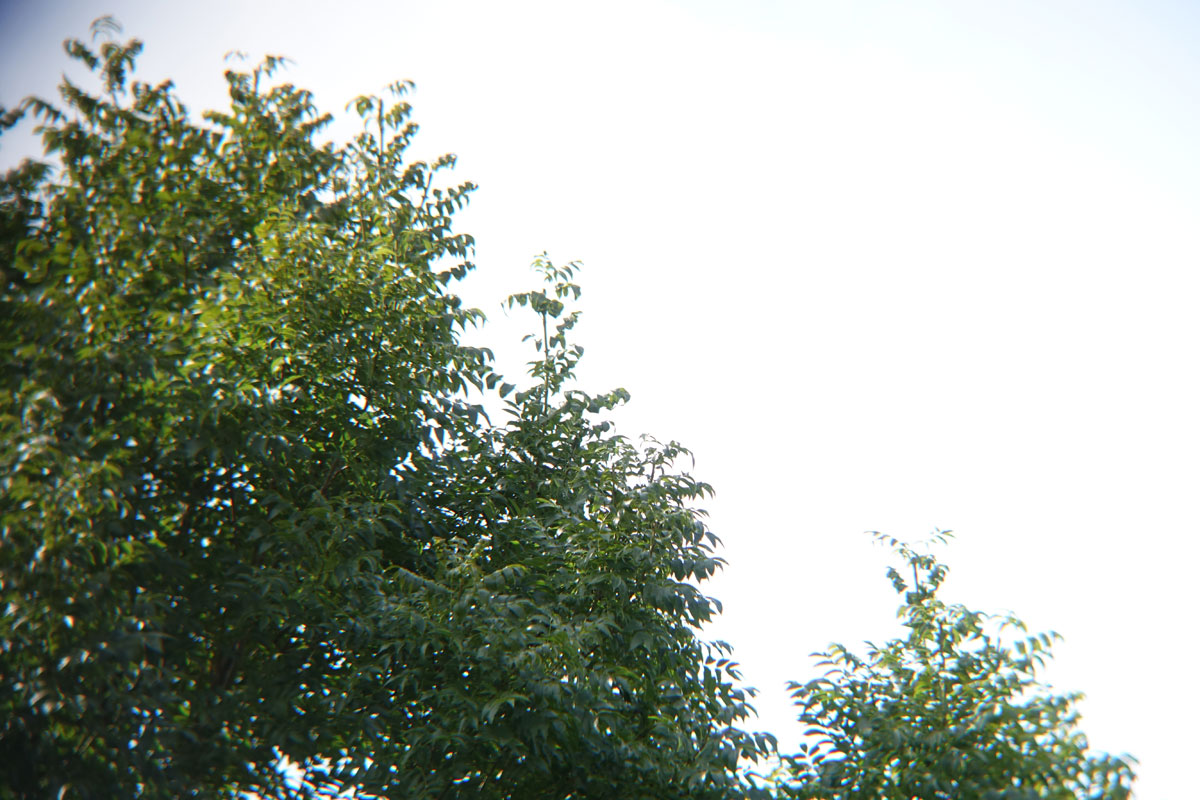 |
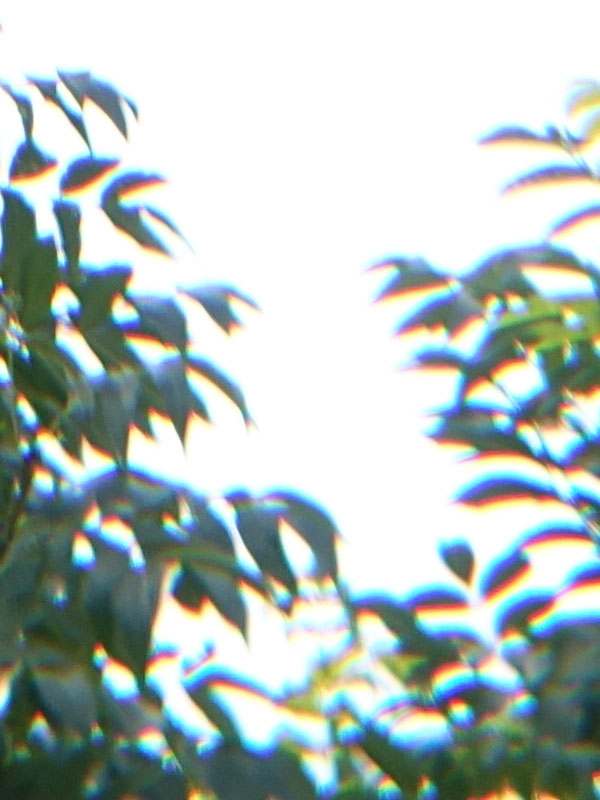 |
Figure: Sample photos with TSED35 (top row) and TSWA32 (bottom row) at the PS 72/432
Figure: Sample photos with TSED35 (top row) and TSWA32 (bottom row) at the ST120
Generally, both eyepieces are very similar, and I found it difficult to find a difference between the two both during the day and at night, especially as I was not able to observe with both at the same time. During the day, I found violet color fringes on TSWA32, whereas on the TSED35 weaker wider yellow color fringes and maybe a very thin violet fringe on the edges as well. Which type of color fringing one prefers is surely a matter of personal preferences... The sample photos with the PS 72/432 may not be representative and do not show the yellow color fringes of the TSED35, but show some blue-green fringes.
Overall, the TSED35 may provide a somewhat sharper image, but I find this hard to judge. At first glance, I see it in the (narrow) lead... With regard to the exit pupil, however, the TSWA32 at the ST120 and also at the Explorer 150PDS with a value of 6.4 is better off than the TSED35 with a value of 7.
Comparison at Night
On our vacation in France in September 2019, I compared both eyepieces once again using the StarTravel 120 at night and was not able to see any differences, especially since I could only look through the eyepieces alternately. The TSWA32 was superior in this combination with respect to focusing, because it had room in both directions, whereas the TSED35 was "at the limit " and just came into focus. A closer inspection at home, however, revealed afterwards that there is a tiny bit of room for focusing with the TSED35.
Issues
Issues with my 2" Zenith Mirror
Figures: ST120 on AZ Pronto mount with 1,25" Lacerta zenith mirror, 10 mm Televue eyepiece and red-dot finder
During my day observations, I did not notice anything because the targets were closer, but when I wanted to observe the moon at dusk, I was not able to focus the moon with some of my eyepieces. The distance produced by the Baader ClickLock adapter seems to be too large. With the 2" rich-field eyepieces, I was able to focus "just," but I did not test exactly whether the image was 100% sharp. Instead, I took out the 1.25" Lacerta zenith mirror from my Skymax-127, removed the 1.25" to 2" adapter from my 2" zenith mirror, placed it in the ClickLock adapter and continued my observation only with 1.25" eyepieces. Between a focal length of 4 mm and 25 mm, all my eyepieces are 1.25" ones anyway.
On September 9, 2019 I tried out all my eyepieces and the borrowed TSWA32 in daylight with a distant target on the 2" and 1.25" zenith mirrors and on the 2" to 1.25" Amici prism. The results are relatively clear:
- 2" zenith mirror: None of my 1.25" eyepieces come into focus, the 2" eyepieces just so - the TSWA32 is best, the 28 mm LET eyepiece is worst.
- 1.25" zenith mirror: All my 1.25" eyepieces come into focus
- 2" to 1.25" Amici prism: All my 1.25" eyepieces come into focus
The results for the 1.25" eyepieces should be transferable to the night because there was still a lot of play when focusing. With respect to the 2" eyepieces I assumed that only the TSWA32 would come into focus at night. A test revealed that all three come into focus at night, the 28 mm eyepiece just so, the TSED35 has a little more room for focusing, whereas the TSWA32 has sufficient room for focusing and is the best in this respect.
Overall, the light path in the 2" zenith mirror seems to be too long. To the owner of the telescope no longer remembers (from a distance...), whether the Baader ClickLock adapter prolongs or shortens the light path compared to the original adapter. Unfortunately, the 2" to 1.25" adapter of the 2" zenith mirror protrudes about 5 mm and thus extends the light path. A flat termination might have helped a bit (there is an adapter from Omegon with just 1 mm thickness, but I am unsure as to whether this would be sufficient). The following illustrations are meant to illustrate the issue:
|
2" zenith mirror with 2" to 1,25" adapter |
Ditto with eyepiece |
|
2" to 1,25" adapter removed |
In this position or even deeper, the telescope came into focus in daylight with this eyepiece |
Photo Attempts
Used as a Spotting Scope
Above I show some photos, which I took for testing purposes only. The depth of field is very shallow, but otherwise I am quite satisfied with the results. Photographing with a T-mount adapter and a resulting focal length of 600 mm does not make much sense to me since my Sony RX10 M4 already does that. And afocal photography is somewhat awkward and not always successful...
Figures: Two samples
Afocal Photography: Moon
On September 9, 2019, the golden handle (Montes Jura) could once again be seen on the moon - and the sky was also clear from time to time. To my surprise, the StarTravel 120/600 turned out to be the ideal telescope for the golden handle, because it colored the golden handle yellow thanks to its color errors. At least on some photos... If you take a closer look, you will find more objects with a yellow tint, particularly along the Terminator.
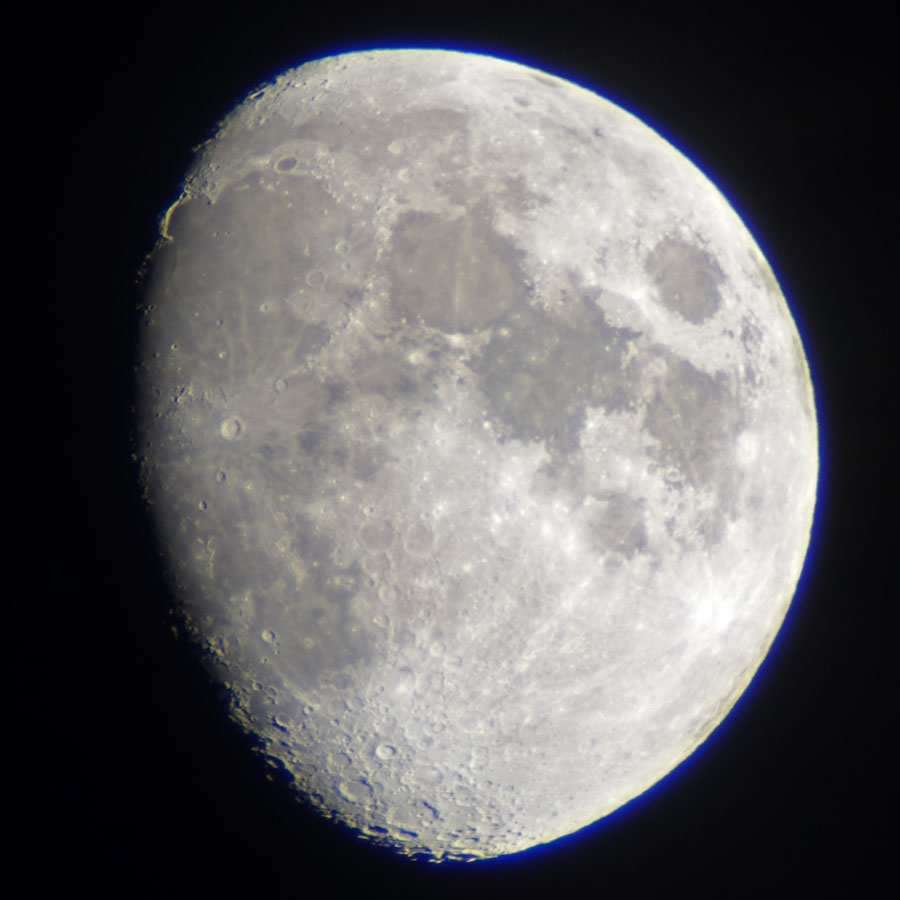 |
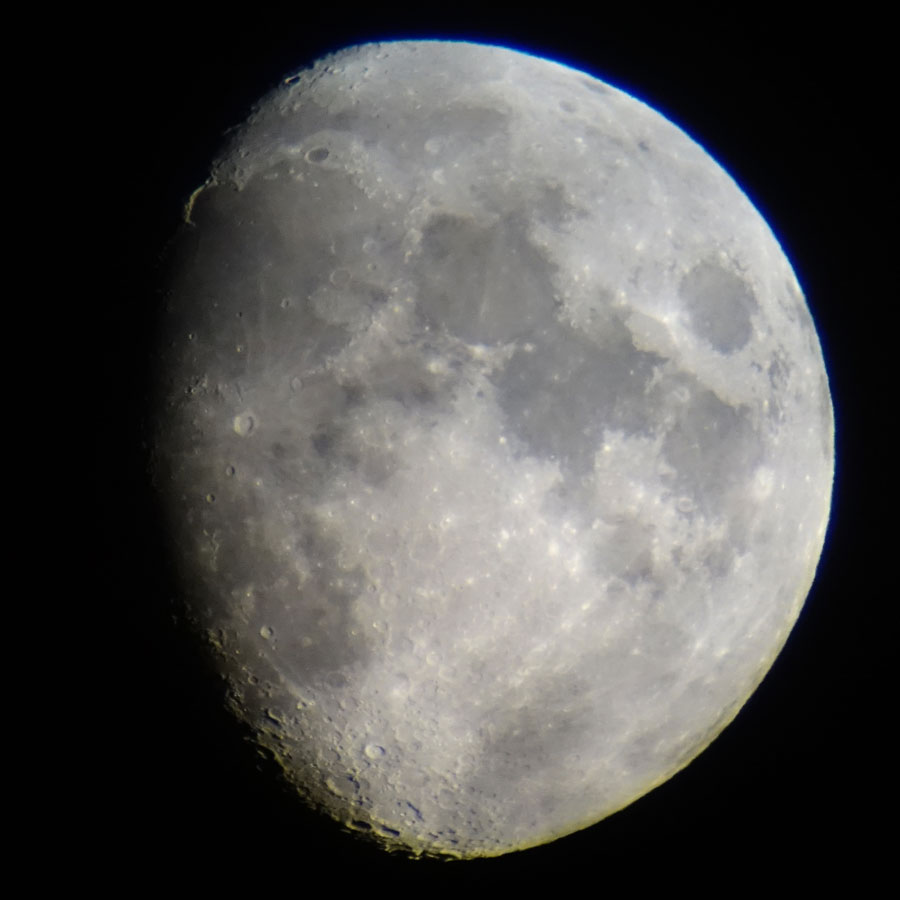 |
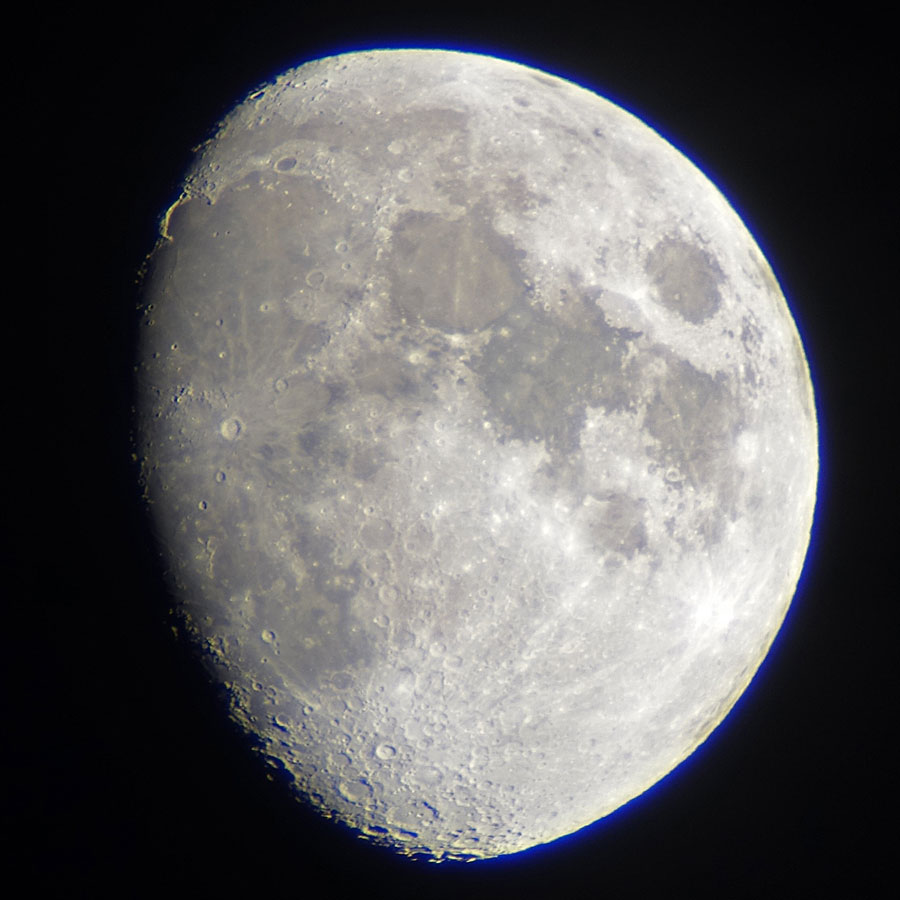 |
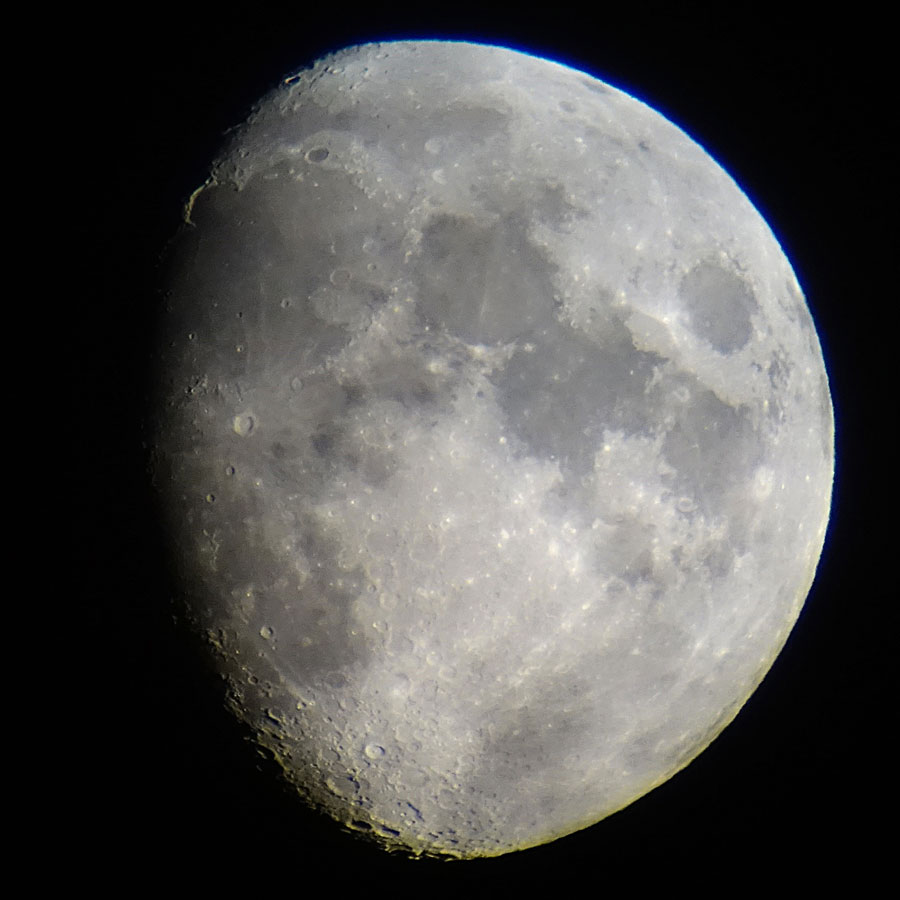 |
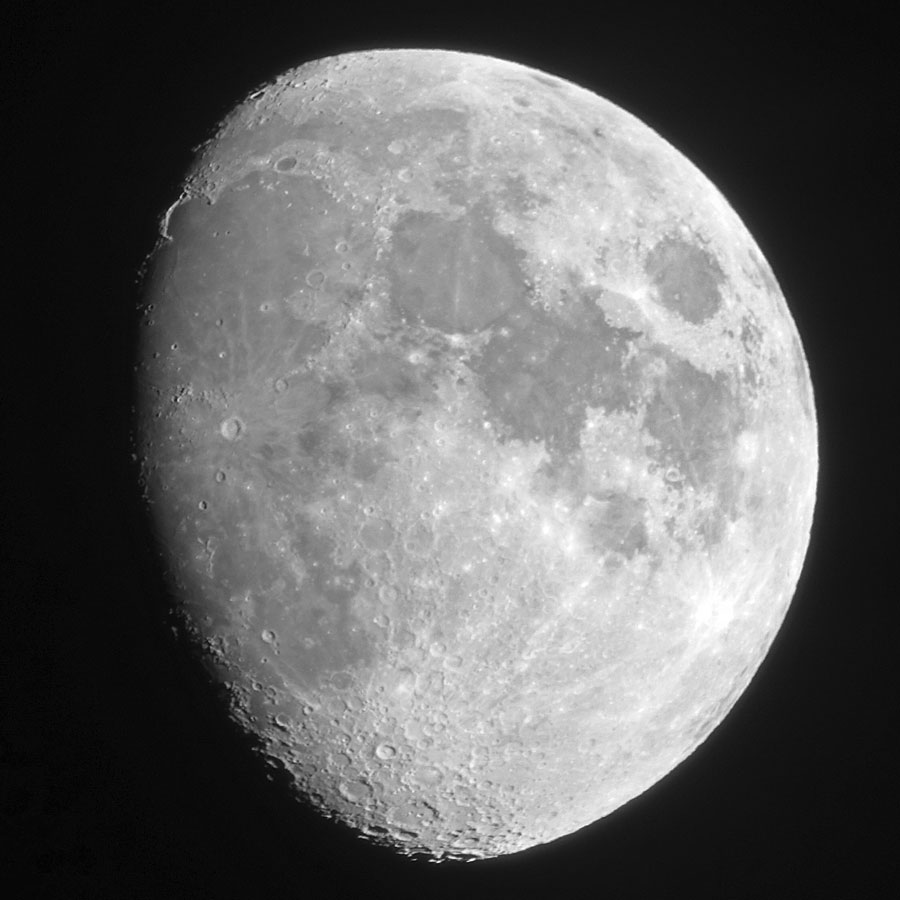 |
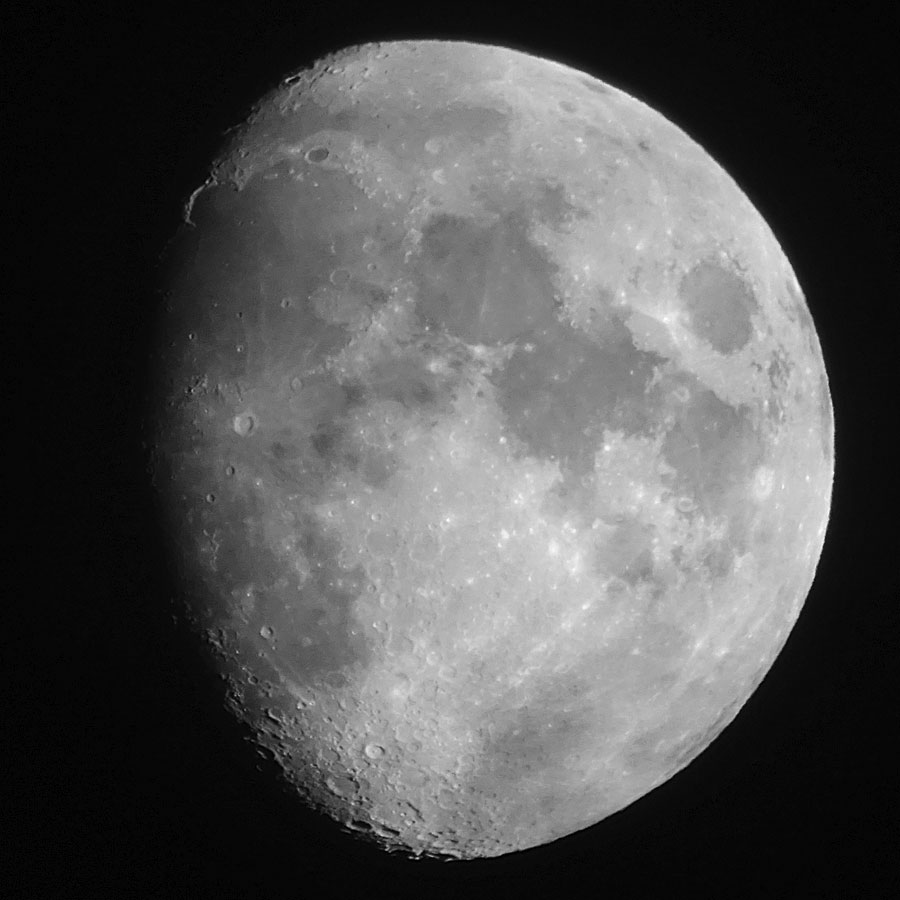 |
Figures: Two samples; on the photo to the right, the gold wandered more to the bottom of the moon... (middle row sharpened, bottom row as well and black & white)
Afocal Photography: Jupiter
On September 9, 2019, I also tried to photograph the Jupiter with a 10 mm eyepiece (60 x magnification) and the Sony RX100 M4, which I simply held to the eyepiece. When looking at the photos, one should take into consideration that the ST120 is not the "ideal" telescope for observing planets due to its short focal length of 600 mm.
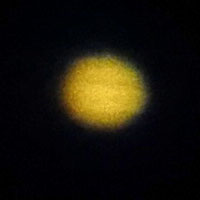 |
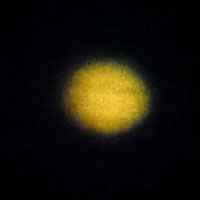 |
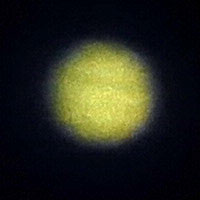 |
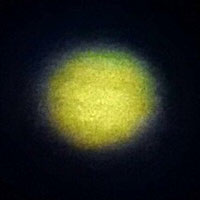 |
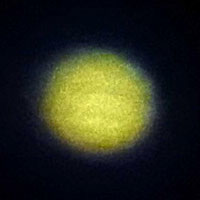 |
Figures: Jupiter with ST120 and 10 mm eyepiece, Sony RX100 M4 held to the eyepiece; the two photos on the left were taken with 50 mm focal length (equivalent), the three right photos with 70 mm focal length (equivalent).
Conclusions
After first tests, a vacation, and some subsequent comparisons with my existing telescopes, I would like to draw my personal and amateur-like conclusions from my "borrowing experiment." I already returned the telescope to its owner.
I had considered buying the Sky-Watcher StarTravel 120/600, because I was looking for telescope that still can be taken with me when traveling and that has a larger aperture than my PS 72/432 refractor and therefore allows me to access more DSOs. My dealer called the telescope "worth considering" despite the well-known color fringes, because it is inexpensive and otherwise has a good image quality (but not as high contrast as an ED or APO refractor). Nevertheless, he advised me not to buy the ST120 because it is too close to my Newton telescope Sky-Watcher Explorer 150PDS. A quick glance at the data of both telescopes confirmed this for me, and I have to agree with him in this respect. But what is not taken into consideration here are handling and travelability. The ST120 still has the latter, but the Explorer 150PDS has not. Regarding the handling, the Explorer 150PDS is already at my "pain limit," especially when unpacking, packing, and assembling it. The ST120 is large, but much more manageable for me.
The owner of the ST120 also told me several times that I do not need this telescope, because I already own two instruments in the same range, namely the the Skymax-127 and the 6" Newton, and both have their special advantages: the Skymax-127 on planets and bright objects at higher magnifications, and the Newton provides more overview than the Skymax-127 and better observation possibilities for DSOs. The ST120 is a pure rich-field telescope, designed for large overviews, but I did not use it for this purpose during my vacation. All this is correct! More about this below in my prp-and-con table!
I have read some customer reviews for the StarTravel 120/600 on the Teleskop-Spezialisten Website and found broad agreement with my experiences. The mentioned weaknesses were due to the Fraunhofer design and a certain curvature of the field of view. The main advantages were the generally good image quality (apart from the color errors caused by the design), the transportability with a large aperture, and the suitability as a wide/rich field telescope.
Here is my list of "arguments" and my comments on them:
| Pro StarTravel 120/600 | Contra StarTravel 120/600 | My Evaluation... | Concl. |
| Good image quality (as long as the magnification is not too high) | Contrast lower as with ED/APO refractors | I cannot comment on this, but according to what I read in the forums this is true... | plus |
Strong color fringes by day and for bright objects (moon, planets, bright stars) |
I have better telescopes for the moon and planets. Therefore, the color fringes disturb me less - I do not look at moon and planets seriously with it (Saturn still looks fine...) | irrelevant to minus | |
| Color fringes do not disturb for DSOs (I do not see any...) | In my experience, I also read this in forums (at a maximum magnification of 50-60 x)... | plus | |
| Rich-Field telescope | For overviews of 3-4°, requires (WA) eyepieces with a long focal length; I did not do this a lot so far, because the search for DSO was more important to me. But I was able to test it to some extent. The PS72 can do that as well (but with less aperture)... | plus | |
| Other telescopes (in general) are better suited to observing DSO (especially those with larger aperture). | True, but they are also larger and heavier, possibly no longer suited to traveling, and no longer manageable for me. | irrelevant | |
| Still suited to traveling | See our vacation in France where we stay at one location. On a holiday with changing places to stay like our holidays in Sweden I would take the PS72 with me at best. But in Sweden the summer nights are too bright for observations anyway... | plus | |
| Still manageable for me | The ST120 is quite long and a bit on the heavy side, but I can still assemble and disassemble it without any problems. | plus | |
| Not another telescope again! | That is true! But it is less about "collecting telescopes" than about "optimizing" my telescope collection. And I am not alone with that... | minus | |
| Existing telescopes: Better than PS72 at DSO, slightly better at DSO than Skymax-127 | Existing telescopes: Not as good as the Explorer 150PDS | The real competition in my "stable" seems to be the Skymax-127, which seems to deliver a similar performance at DSOs, is better at moon and planets, and even fits into a small Sky-Watcher bag, so it is "travelable." I almost took it with me to France, but then the ST120 dropped in... | well... |
| ... | ... | ... | ... |
All in all, after this "borrowing experiment", I was as smart as before when it came to a purchase decision. In any case, I made a lot of interesting experiences with the ST120 and learned a lot about refractors of this type - and it still itched a little in my fingers afterwards... Nevertheless, it looked as if I would give up purchasing an ST120 and use the Skymax-127 for DSO observations a little bit more. And of course also the Explorer 150PDS (as long as I owned it) or the C8 (which replaced the Explorer), if I could bestir myself to use it...
But it turned out quite differently, because I decided to replace the Explorer 150PDS with a Celestron C8 (end of 2019). I kept the Skymax-127, although I wanted to sell it first as well, because it is (fairly) well suited to travelling. And finally, in July 2020, I bought an APO refractor (TLAPO1207), with less aperture, but certainly much better image quality.That tube is, however, definitely not suited to travelling...
Links
- Sky-Watcher BK 1206AZ3: skywatcher.com/product/bk-1206az3
- TS-Optics 32 mm 2" - 70° Wide Angle Eyepiece: www.teleskop-express.de/shop/product_info.php/language/en/info/p956_TS-Optics-32-mm-2----70--Weitwinkelokular.html
- TS-Optics 35 mm 2" UFL Eyepiece - 69° Field of View - 6 Element Design: www.teleskop-express.de/shop/product_info.php/info/p2334_TS-Optics-35-mm-2--UFL-Eyepiece---69--Field-of-View---6-Element-Design.html
- See also my page offering Astronomy Links.
Appendix: Data for Sky-Watcher Refractor 120/600
Technical Data
| Telescope: Sky-Watcher StarTravel | ST120 |
| Optical Design | Refractor |
| Primary Mirror Diameter | 120 mm (4.7") |
| Focal Length, Focal Ratio | 600 mm, f/5 |
| Resolving Power (arc secs) | 0.96" |
| Limiting Visual Stellar Magnitude | 13.1 mag |
| Light Gathering Power | 290 |
| Maximum Practical Visual Power | 240 x |
| Optical Tube Dimensions (diam. x length) | 116/142 mm x 660 mm |
| Net Weight Basis | --- |
| Net Weight Optical Tube | 4.0 kg |
| Net Weight Complete | --- |
Dark Blue: Telescopes that I still own; italic and dark red: telescopes that I owned; black: for comparison; *) own measurement; **) corrected values
See also the table of data for all of my telescopes (and a few more...)
Observation-Relevant Data (in Comparison with My Refractor and My Newton Tube)
| Telescope | Focal |
Aperture (mm) |
Focal Ratio |
Light Gathering Power |
Maximum+ |
Minimum* |
Maximum* |
Minimum+ |
|||||
Usable Magnification |
Usable Focal
Length of Eyepiece (mm) |
||||||||||||
Factor/Exit Pupil (mm) > |
Manuf. |
1.5 |
2 |
6.5 |
7 |
6.5 |
7 |
1.5 |
2 |
||||
| PS 72/432 | 432 |
72 |
6 |
106 |
144 |
108 |
144 |
11.08 |
10.29 |
39.0 |
42.0 |
4.0 |
3.0 |
| ST120 | 600 |
120 |
5 |
290 |
180 |
240 |
18.46 |
17.14 |
32.5 |
35.0 |
3.3 |
2.5 |
|
| TS-Optics Photoline 102 mm f/7 | 714 |
102 |
7 |
212,3 |
--- |
204 |
15.69 |
14.57 |
45.5 |
49.0 |
4.7 |
3.5 |
|
| Explorer PDS150/Dobson 6" | 750 |
150
|
5 |
459 |
225 |
300 |
23.08 |
21.43 |
32.5 |
35.0 |
3.3 |
2.5 |
|
*) Calculated for an exit pupil of 6.5 mm and 7 mm
+) Factor 1.5 or 2 for Dobsonian/Newtonian telescopes; in general, the lower
value of 1.5 is used for Newtonian telescopes; if the manufacturer specified
a different magnification, it is also listed (some manufacturer provide considerably
higher numbers...).
Visual Power (Magnification) and Other Data for Different Focal Lengths of Eyepieces (Mostly My Current Eyepieces)
Note: These tables include a TSWA32 eyepiece (2", 32 mm focal length, 70° viewing angle) that I borrowed together with the StarTravel 120, a 38 mm eyepiece (2", 70 ° viewing angle), and a 56 mm eyepiece (2", 52 ° viewing angle).
| Telescope | Further Data |
Focal Length of Eyepiece (mm) |
|||||||||||||
| Magnification | |||||||||||||||
Focal Length of Telescope (mm) |
4 |
7 |
10 |
16 |
18 |
24 |
26 |
28 |
32 |
32 |
35 |
38 |
40 |
56 |
|
| PS 72/432 | 432 |
108.00 |
61.71 |
43.20 |
27.00 |
24.00 |
18.00 |
16.62 |
15.43 |
13.50 |
13.50 |
12.34 |
11.37 |
10.80 |
7.71 |
| ST120 | 600 |
150.00 |
85.71 |
60.00 |
37.50 |
33.33 |
25.00 |
23.08 |
21.43 |
18.75 |
18.75 |
17.14 |
15.79 |
15.00 |
10.71 |
| TLAPO1027 | 714 |
178.50 |
102.00 |
71.40 |
44.63 |
39.67 |
29.75 |
27.46 |
25.50 |
22.31 |
22.31 |
20.40 |
18.79 |
17.85 |
12.75 |
| 150PDS | 750 |
187.50 |
107.14 |
75.00 |
46.88 |
41.67 |
31.25 |
28.85 |
26.79 |
23.44 |
23.44 |
21.43 |
19.74 |
18.75 |
13.39 |
| Skymax-127 | 1500 |
375.00 |
214.29 |
150.00 |
93.75 |
--- |
62.50 |
--- |
--- |
46.88 |
--- |
--- |
--- |
--- |
--- |
| C8 | 2032 |
508.00 |
290.29 |
203.20 |
127.00 |
112.89 |
84.67 |
78.15 |
72.57 |
63.50 |
63.50 |
58.06 |
53.47 |
50.80 |
36.29 |
| C8 (Red.) | 1280 |
320.00 |
182.86 |
128.00 |
80.00 |
--- |
53.33 |
--- |
--- |
40.00 |
--- |
--- |
--- |
--- |
--- |
| True Field of View (°) | |||||||||||||||
Apparent Field
of View (°) > |
82 |
82 |
72 |
82 |
82 |
65 |
70 |
56 |
52 |
70 |
69 |
70 |
68 |
52 |
|
Focal Length of Telescope (mm) |
4 |
7 |
10 |
16 |
18 |
24 |
26 |
28 |
32 |
32 |
35 |
38 |
40 |
56 |
|
| PS 72/432 | 432 |
0.76 |
1.33 |
1.67 |
3.04 |
3.42 |
3.61 |
4.21 |
3.63 |
3.85 |
5.19 |
5.59 |
6.16 |
6.30 |
6.74 |
| ST120 | 600 |
0.55 |
0.96 |
1.20 |
2.19 |
2.46 |
2.60 |
3.03 |
2.61 |
2.77 |
3.73 |
4.03 |
4.43 |
4.53 |
4.85 |
| TLAPO1027 | 714 |
0.46 |
0.80 |
0.91 |
1.84 |
2.07 |
2.18 |
2.55 |
2.20 |
2.33 |
3.14 |
3.38 |
3.73 |
3.92 |
4.08 |
| 150PDS | 750 |
0.44 |
0.77 |
0.96 |
1.75 |
1.97 |
2.08 |
2.43 |
2.09 |
2.22 |
2.99 |
3.22 |
3.55 |
3.63 |
3.88 |
| Skymax-127 | 1500 |
0.22 |
0.38 |
0.48 |
0.87 |
--- |
1.04 |
--- |
--- |
1.11 |
--- |
--- |
--- |
--- |
--- |
| C8 | 2032 |
0.16 |
0.28 |
0.35 |
0.65 |
0.73 |
0.77 |
0.90 |
0.77 |
0.82 |
1.10 |
1.19 |
1.31 |
1.34 |
1.43 |
| C8 (Red.) | 1280 |
0.26 |
0.45 |
0.63 |
1.03 |
--- |
1.22 |
--- |
--- |
1.30 |
--- |
--- |
--- |
--- |
--- |
| Exit Pupil (mm) | |||||||||||||||
Focal Ratio |
4 |
7 |
10 |
16 |
18 |
24 |
26 |
28 |
32 |
32 |
35 |
38 |
40 |
56 |
|
| PS 72/432 | 6 |
0.67 |
1.17 |
1.67 |
2.67 |
3.00 |
4.00 |
4.33 |
4.67 |
5.33 |
5.33 |
5.83 |
6.33 |
6.67 |
9.33 |
| ST120 | 5 |
0.80 |
1.40 |
2.00 |
3.20 |
3.60 |
4.80 |
5.20 |
5.60 |
6.40 |
6.40 |
7.00 |
7.60 |
8.00 |
11.20 |
| TLAPO1027 | 7 |
0.57 |
1.00 |
1.43 |
2.29 |
2.57 |
3.43 |
3.71 |
4.00 |
4.57 |
4.57 |
5.00 |
5.43 |
5.71 |
8.00 |
| 150PDS | 5 |
0.80 |
1.40 |
2.00 |
3.20 |
3.60 |
4.80 |
5.20 |
5.60 |
6.40 |
6.40 |
7.00 |
7.60 |
8.00 |
11.20 |
| Skymax-127 | 11.81 |
0.34 |
0.59 |
0.85 |
1.35 |
--- |
2.03 |
--- |
--- |
2.71 |
--- |
--- |
--- |
--- |
--- |
| C8 | 10 |
0.40 |
0.70 |
1.00 |
1.60 |
1.80 |
2.40 |
2.60 |
2.80 |
3.20 |
3.20 |
3.50 |
3.80 |
4.00 |
5.60 |
| C8 (Red.) | 6.3 |
0.63 |
1.11 |
1.59 |
2.54 |
--- |
3.81 |
--- |
--- |
5.08 |
--- |
--- |
--- |
--- |
--- |
Blue: Equipment borrowed for comparison purposes; gray: sold equipment; italic: 2" eyepieces
Magnification: Yellow: low (30-50 x); magenta: medium
(80-100 x); violet: high (150-200 x - and more); red: beyond
maximum usable magnification.
Exit pupil: Values in magenta cells are
either too small (< 1 mm) or too large (> 6.4/7 mm); yellow background:
best for galaxies (about 2-3 mm).
Recommendations for the Focal Lengths of Eyepieces for StarTravel 120/600 (Following My Recommendations and Those of Others)
| Criteria | Exit Pupil |
Focal
Length of Eyepiece |
|||||
| Category | Application Area | from...to |
Calculated |
On the Market |
Examples |
Proposals |
|
| Maximum FOV | Search | 7 |
10 |
35-50 |
35-56* |
35...40* |
35, 38, 40 |
| Minimum Magnification / Large FOV | Overview, large-area nebulae | 4.5 |
6.5 |
22.5-33.5 |
20-32* |
25...32* |
25, 26, 28, 32 |
| Normal Magnification | Large-area, faint nebulae; nebulae, open star clusters | 3.5 |
4 |
17-20 |
16-20* |
16...20 |
16, 18, 20 |
| Best for many objects, e.g. for most galaxies, and mid-size DSO | 2 |
3 |
10-15 |
10-15 |
10, 12, 15 |
10, 12, 15 |
|
| Maximum Magnification / Maximum Resolution | "Normal" upper magnification limit; globular star clusters | 1 |
1.5 |
5-7.5 |
5-7.5 |
5, 6, 7 |
(5, 6, 7)*** |
| Maximum perceptibility of small, low-contrast
details; planetary nebulae, small galaxies; maximum magnification for moon and planets |
0.6 |
0.8 |
3.0-4.0 |
3-4 |
3, 3.5, 4 |
(3.5, 4)*** |
|
| Separation of narrow double stars, small planetary
nebulae; perception of faintest details |
0.4 |
0.5 |
2.0-2.5 |
2-2.5 |
2.5 |
--- |
|
*) Partly available as 2" eyepiece; **) typically no suitable 1,25" eyepieces available; problems with viewing at 40 mm; italic: not possible; red: magnification too high; blue: commercial focal lengths; ***) the ST120 is a rich-field telescope and many users do not go beyond a magnification of 60 x (I used it with a magnification of up to 150 x (= 4 mm))
Appendix 2: Sky-Watcher StarTravel 120/600 Report (for Teleskop-Spezialisten, Translated)
In September 2019, I borrowed the Sky-Watcher StarTravel 120/600 from a starfriend and took it on holiday to France (Sumène, Haute Loire). There the sky is clearly darker than in my place of residence Mühlhausen/Kraichgau (the astronomy club Orion43 has its observatory not far from our camping site in Le Betz). I also took my small ED refractor Omegon PS 72/432 with me and compared both refractors, but that did not really happen.
During the first three nights, the sky was dark from about 21 o'clock on and the Milky Way could be seen well, but from about 22 to 23 o'clock the rising and waning moon became noticeable, and the Milky Way gradually disappeared. In the time in between, I was able to observe a number of objects with the ST120, namely in the first and third night. In the second night, I observed with my PS 72/432 with probably darker sky and was also able to observe with telescope all objects in a - for me - similar quality as with the ST120. Since I could not use both telescopes at the same time, however, a comparison was difficult and had to be delayed until I was back home. After that I did not use the PS72 on vacation anymore.
Until the end of our vacation I made, with interruptions, further observations with the ST120; now the moon disturbed far less or not at all anymore. I also did some rich-field observations with my TSED35 eyepiece and a borrowed TSWA32 eyepiece, but my focus was on "harvesting DSOs" to get an idea of what objects I can find with the ST120. All in all, I observed about 50 DSOs during the three weeks of vacation, among them about 20 new ones for me, because I wanted to extend my list of observed DSOs a little bit:
- M 2, M 4, M 8, M 9, M 10, M 11, M 12, M 13, M 14, M 15, M 16, M 17, M 18, M 19, M 20, M 21, M 22, M 23, M 24, M 25, M 26, M 27, M 28, M 31, M 33, M 34, M 35, M 42/43, M 45, M 51, M 54, M 55, M 56, M 57, M 69, M 70, M 71, M 75, M 76, M 80, M 81/82, M 92, M 103, M 107
- Mel 20
- NGC 457, NGC 663/NGC 654, NGC 752, NGC 884/NGC 869, NGC 7000
- Kemble's Cascade, Cr 399
All in all I, was very impressed by the StarTravel 120/600 regarding the observation of DSO, particularly since I was not able to recognize any disturbing color fringes with these. I knew that the StarTravel is considered as a "color thrower/bucket," and I was able to confirm this as when observing during the day, the moon and planets, but this was not my "topic" for the observations during my vacations.
I did not pay attention to the sometimes criticized curvature of the field of view, but at higher magnifications the focusing became more and more tricky. However, many owners rarely go beyond a magnification of 40-60 x, and there the telescope can still be easily focused.
I myself did not have any "headaches" magnifying with the StarTravel 120/600 and my 7 mm and 4 mm eyepieces up to 150 times if needed, for example in order to resolve star clusters or to see fine stars in open star clusters such as M 11. With my PS 72/432, on the other hand, the limit is reached at about 100, and above that, the view in the eyepiece would be very dark anyway...
At home, I compared the StarTravel 120/600 once more at a few selected objects, especially at M 11 (wild duck cluster) (the weather did not allow for more). Basically, it turned out that the performance follows the aperture values (assuming that a Maksutov-Cassegrain "suffers" a bit from its obstruction):
- Explorer 150PDS (6" Newton) > StarTravel 120/600 (120 mm refractor) > Skymax-127 (5" Maksutov-Cassegrain) > PS 72/432 (72 mm refractor).
After this "lending experiment" I do not know whether I will buy the StarTravel 120/600, because it is too similar to my 6" Newton with respect to the technical data. But I know from this experience that the ST120 refractor is definitely a good (and maybe a bit too big) telescope for observing deep sky objects - and also for home use, if you do not want to have a lot of effort when observing. For sun, moon, and planets I have more suitable telescopes in my "stock" (even if a yellow filter can help, for example, at the moon).
Of course, I also lack comparisons with good APO refractors, which would probably provide much better contrast. But they are not cheap, whereas the StarTravel 120/600 is very affordable.
| 21.11.2024 |
